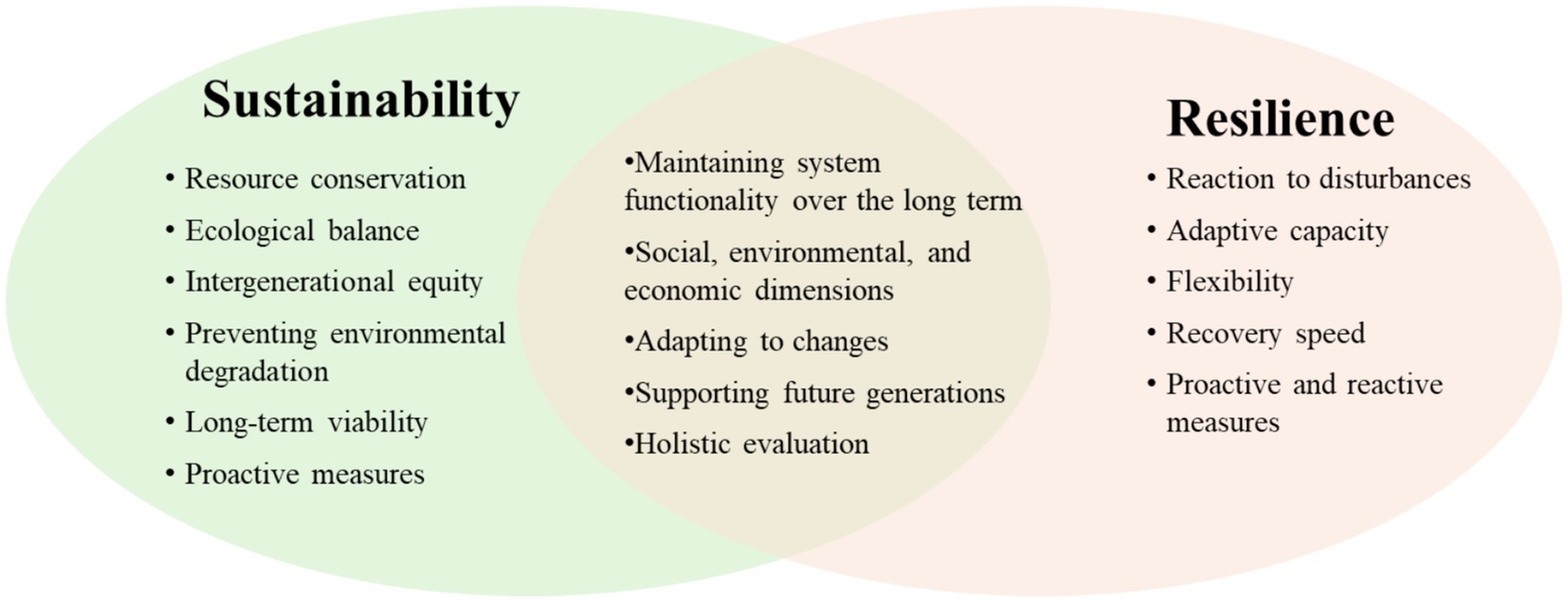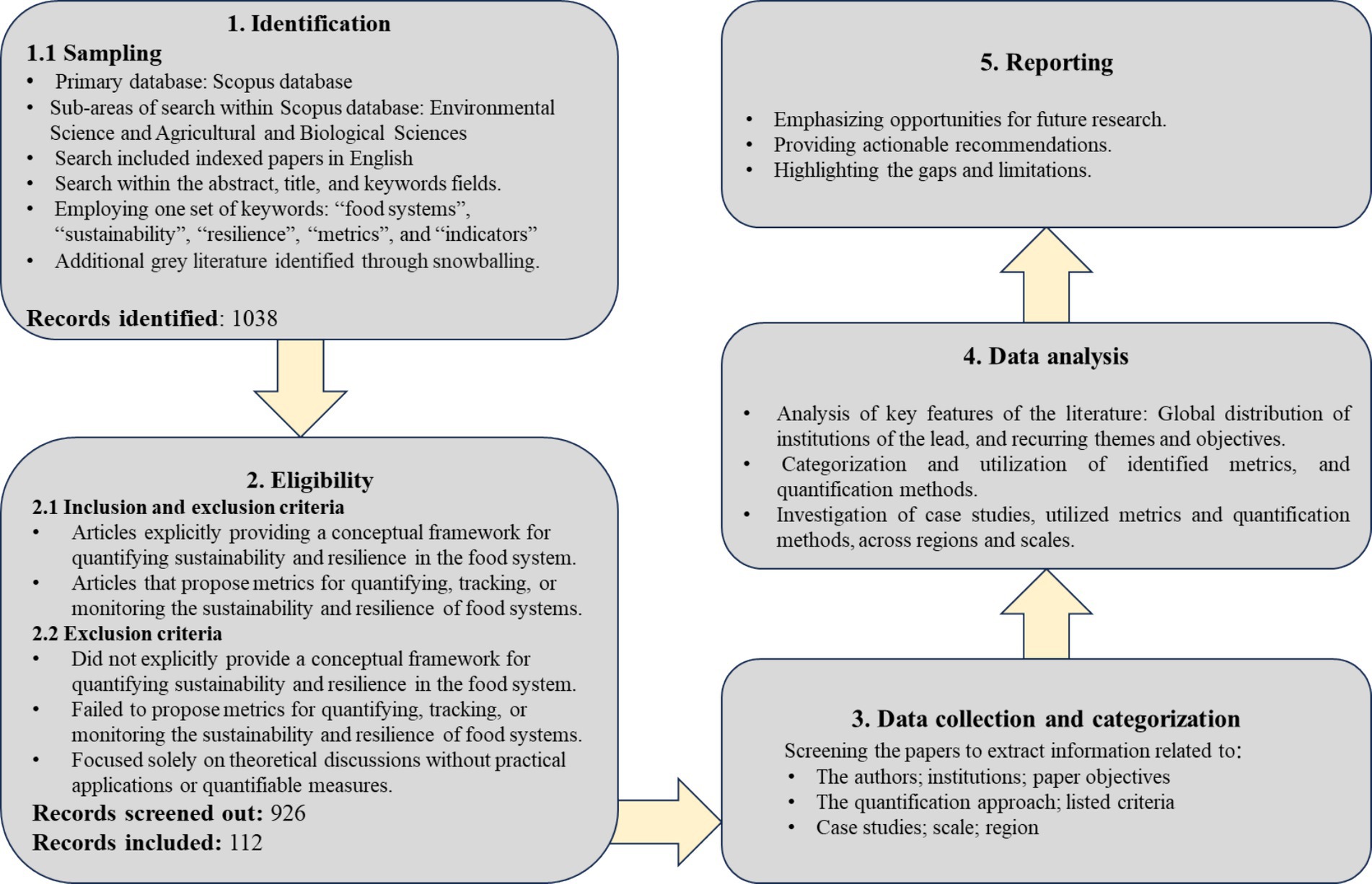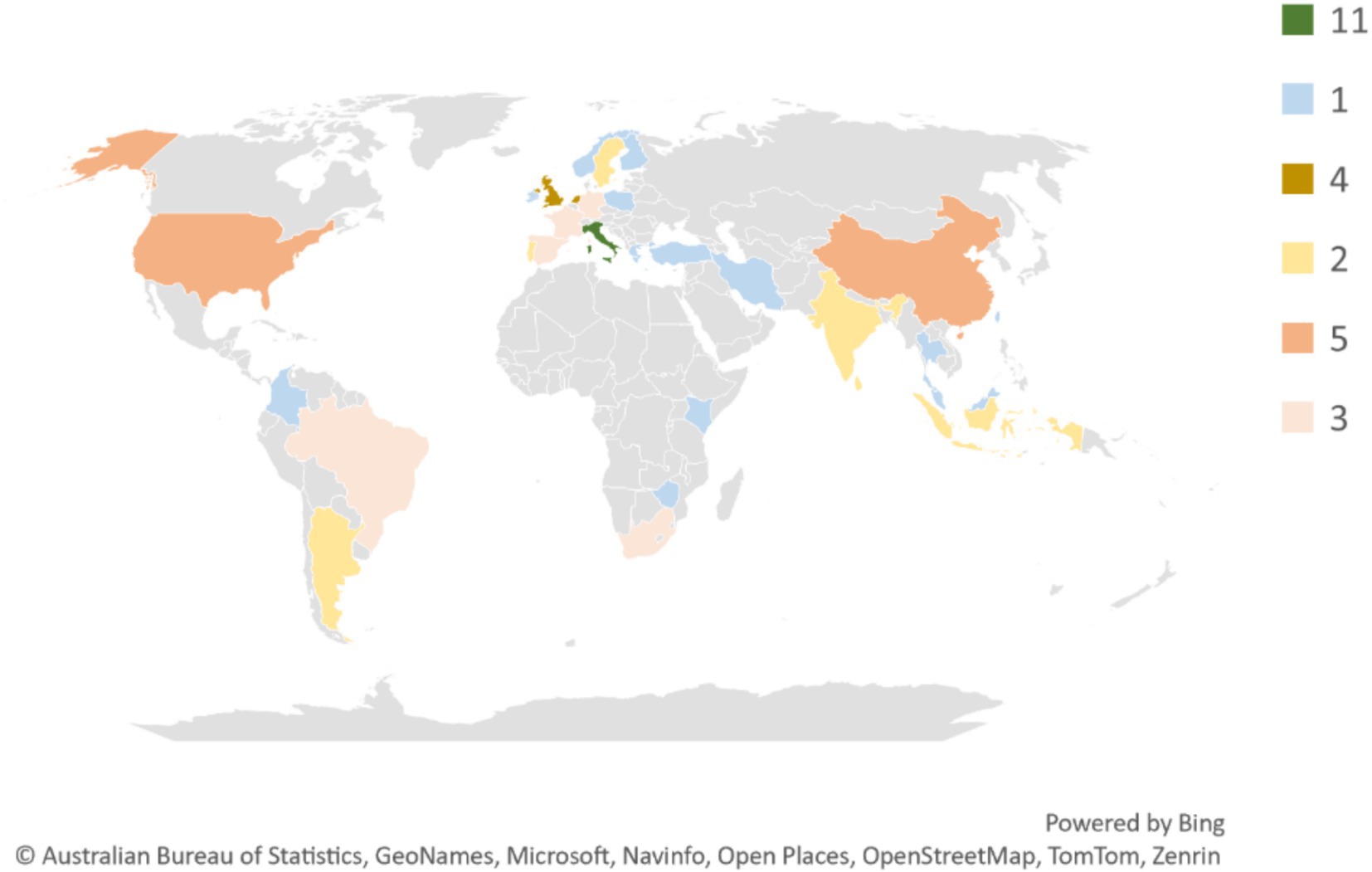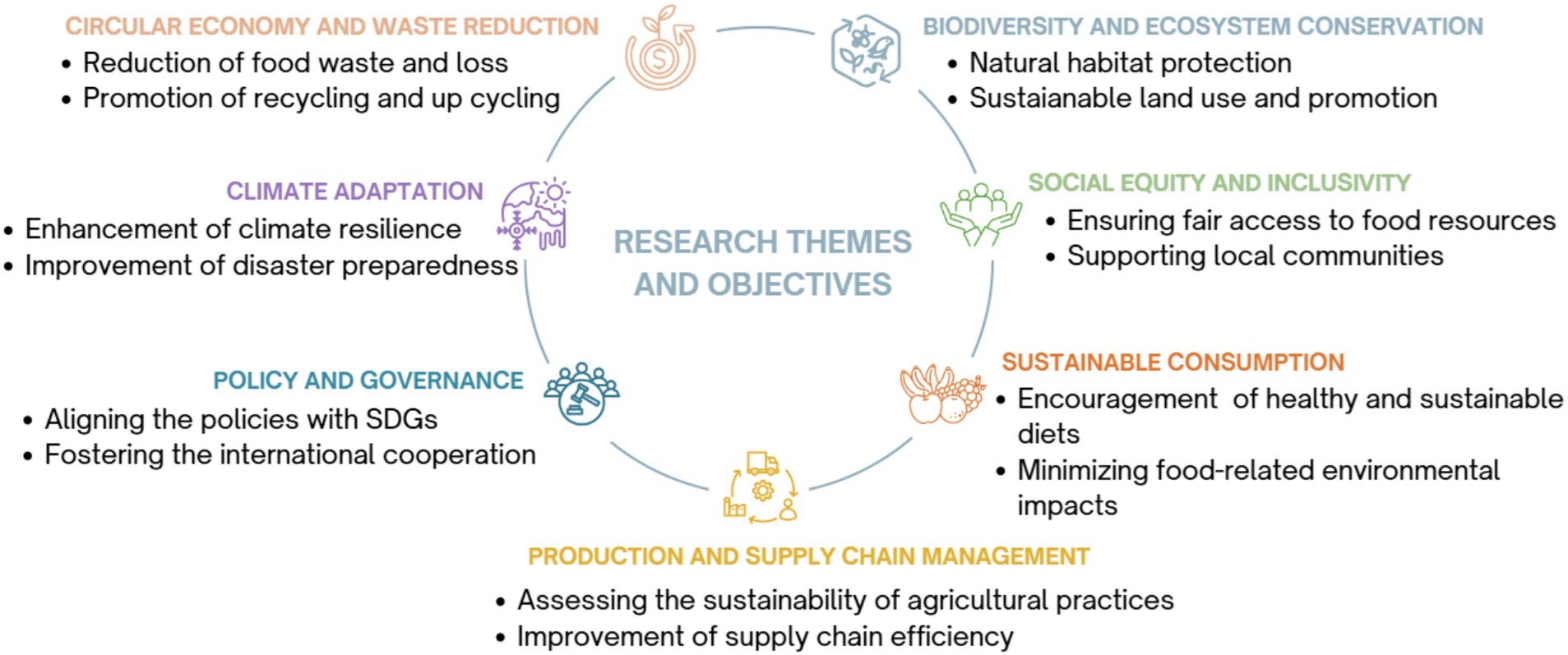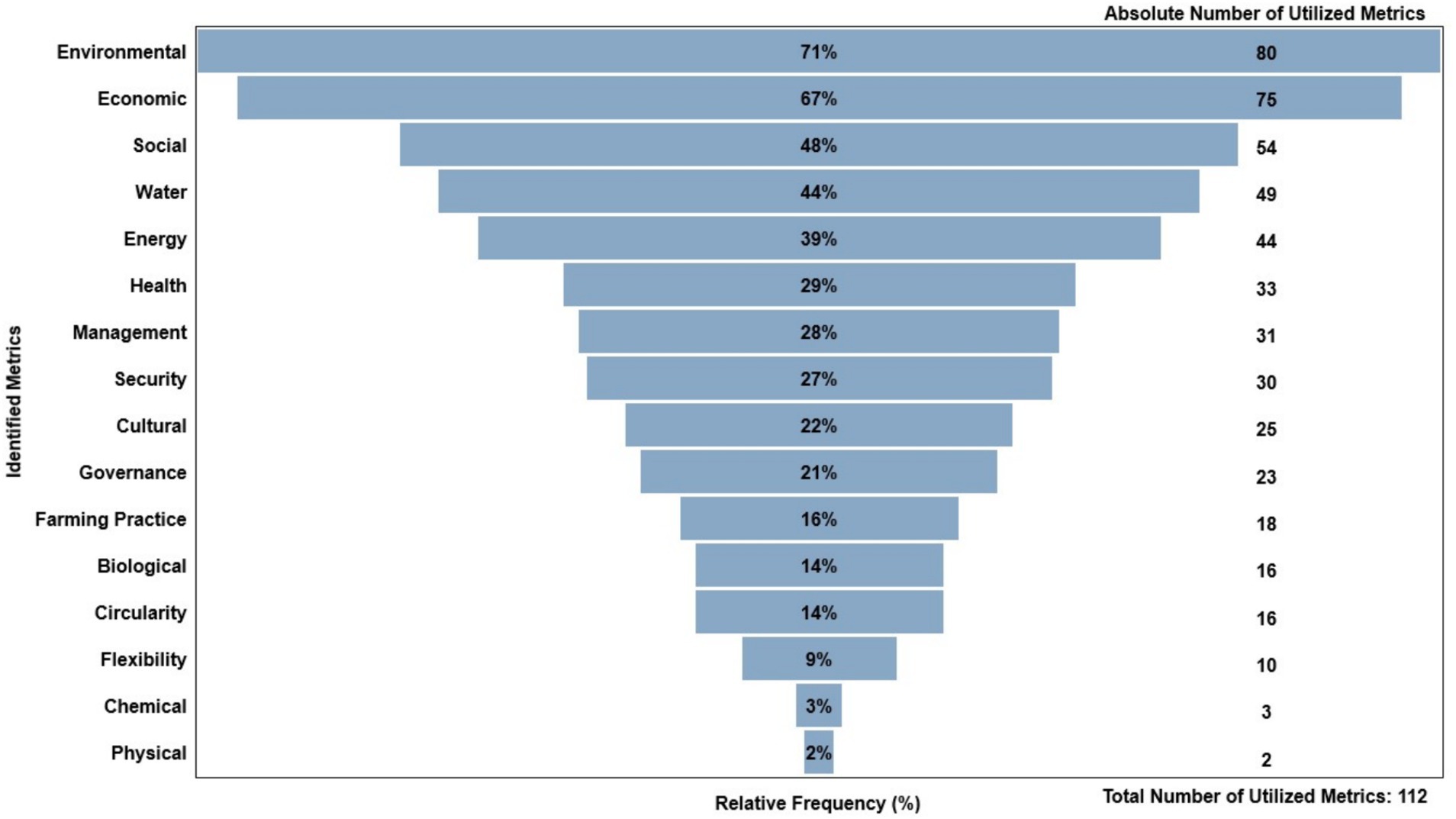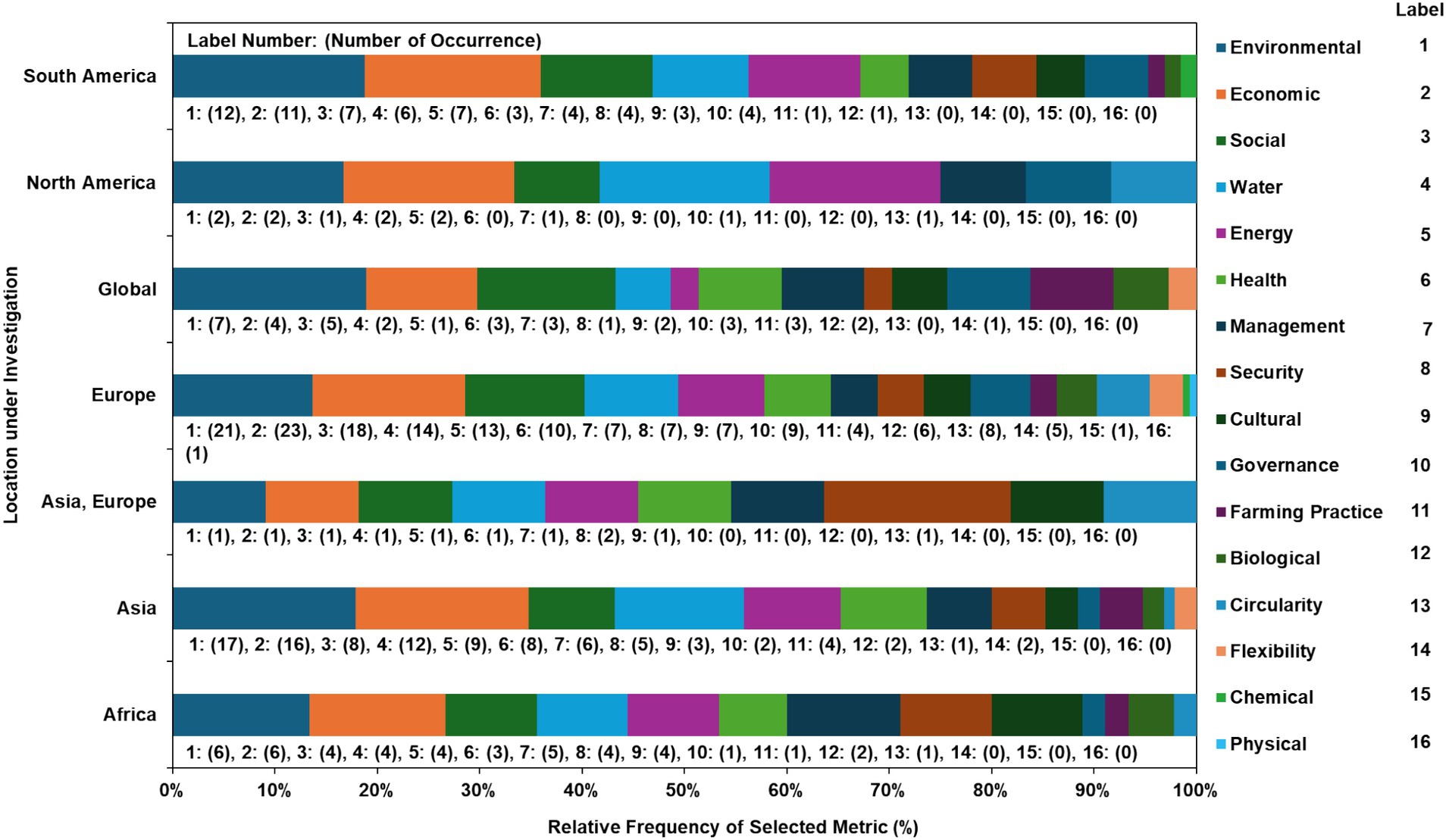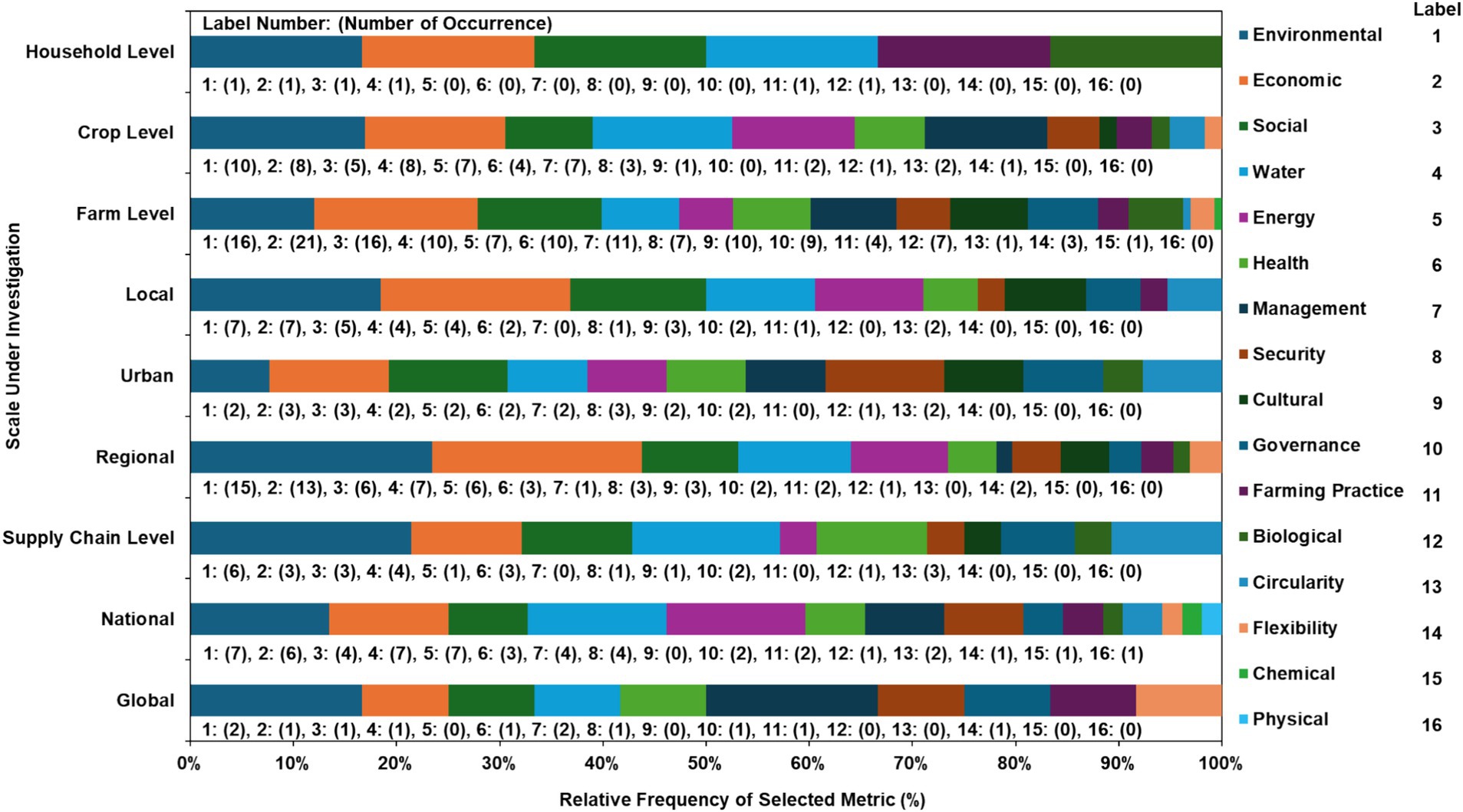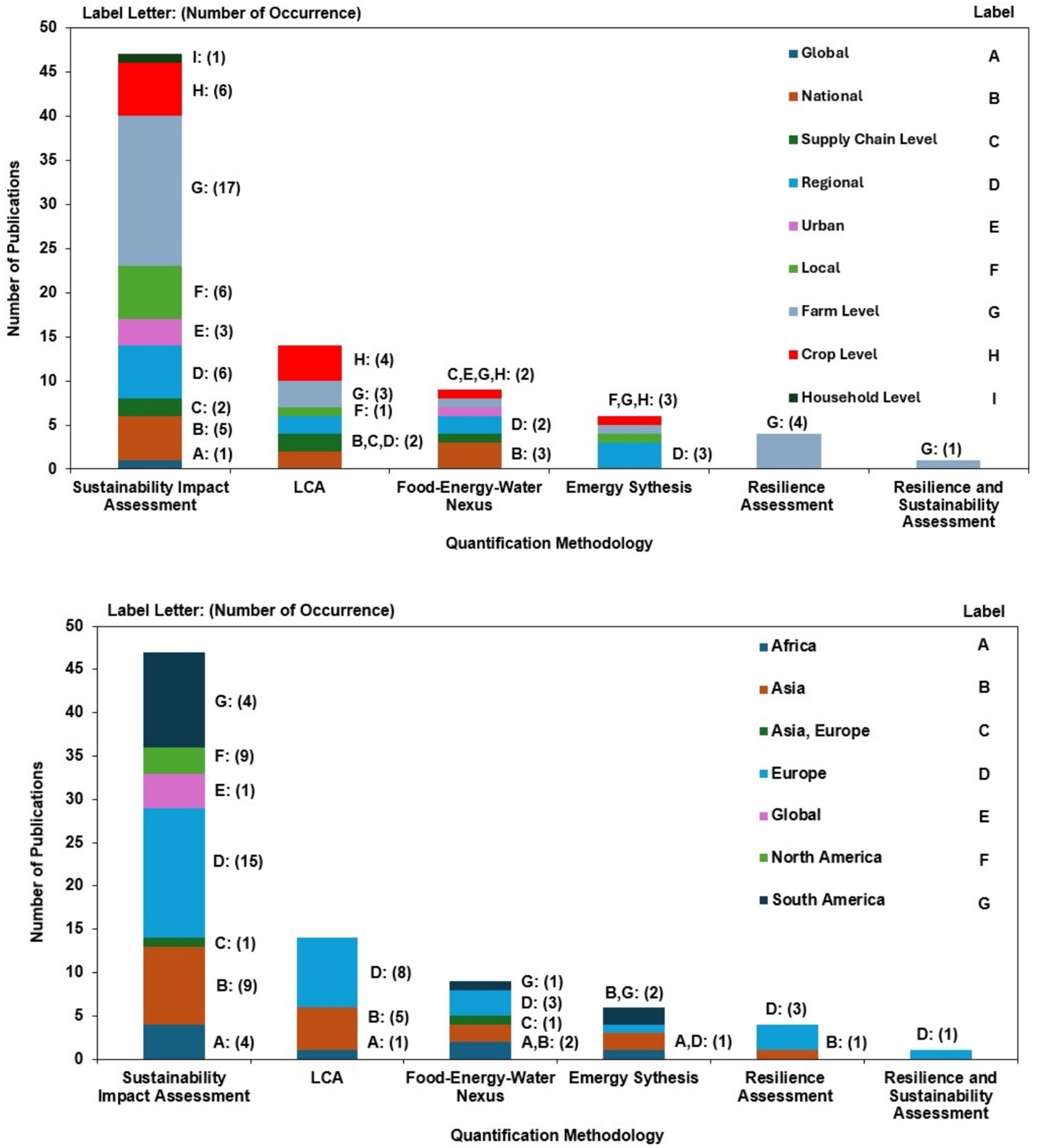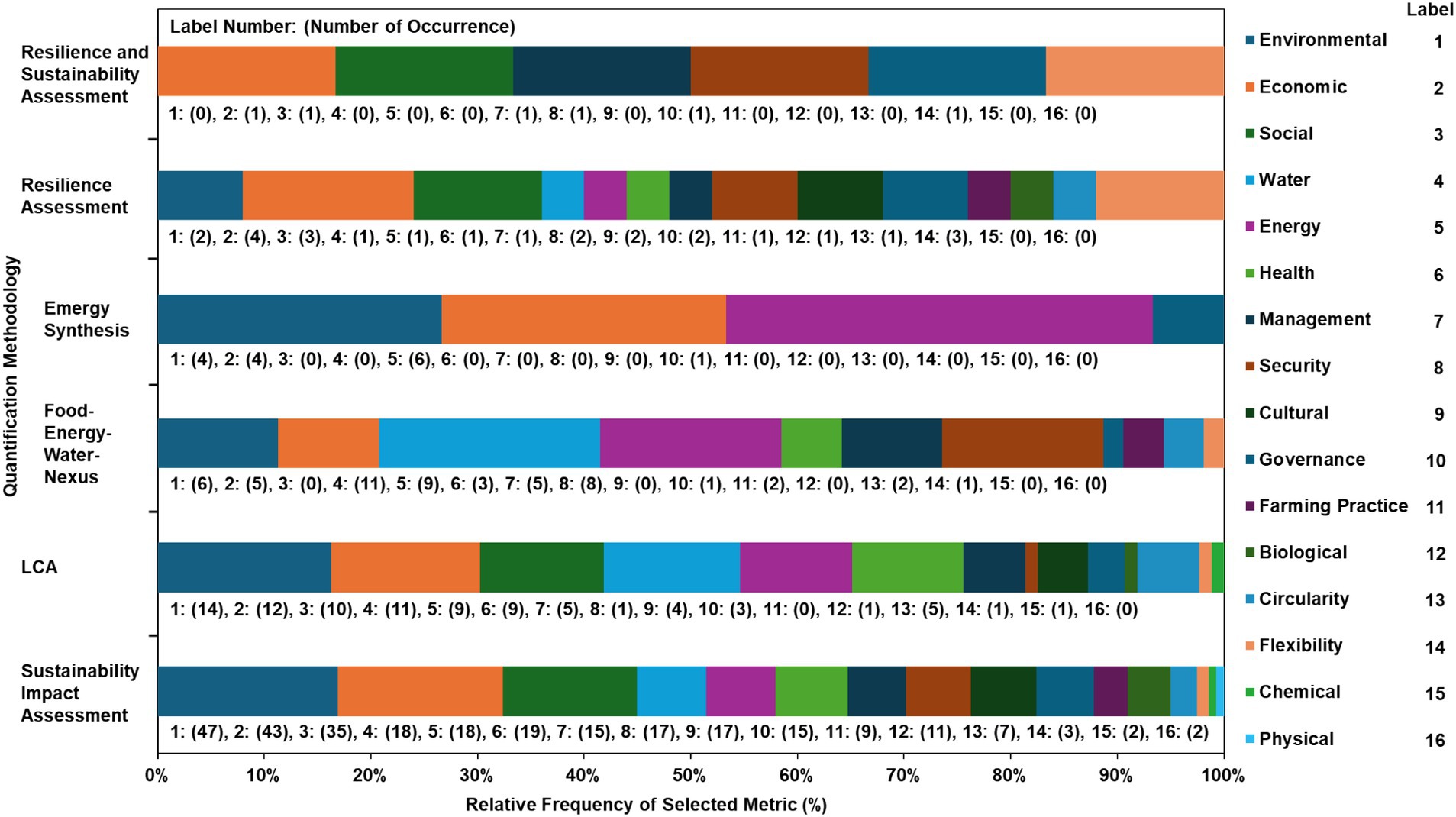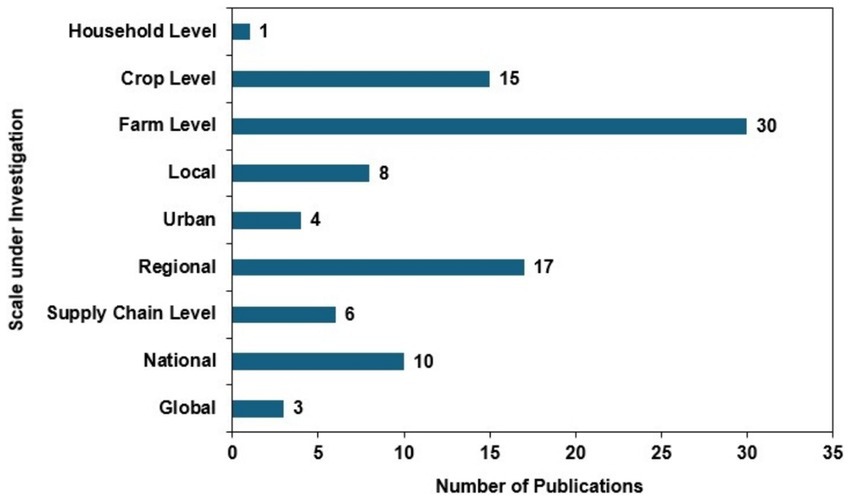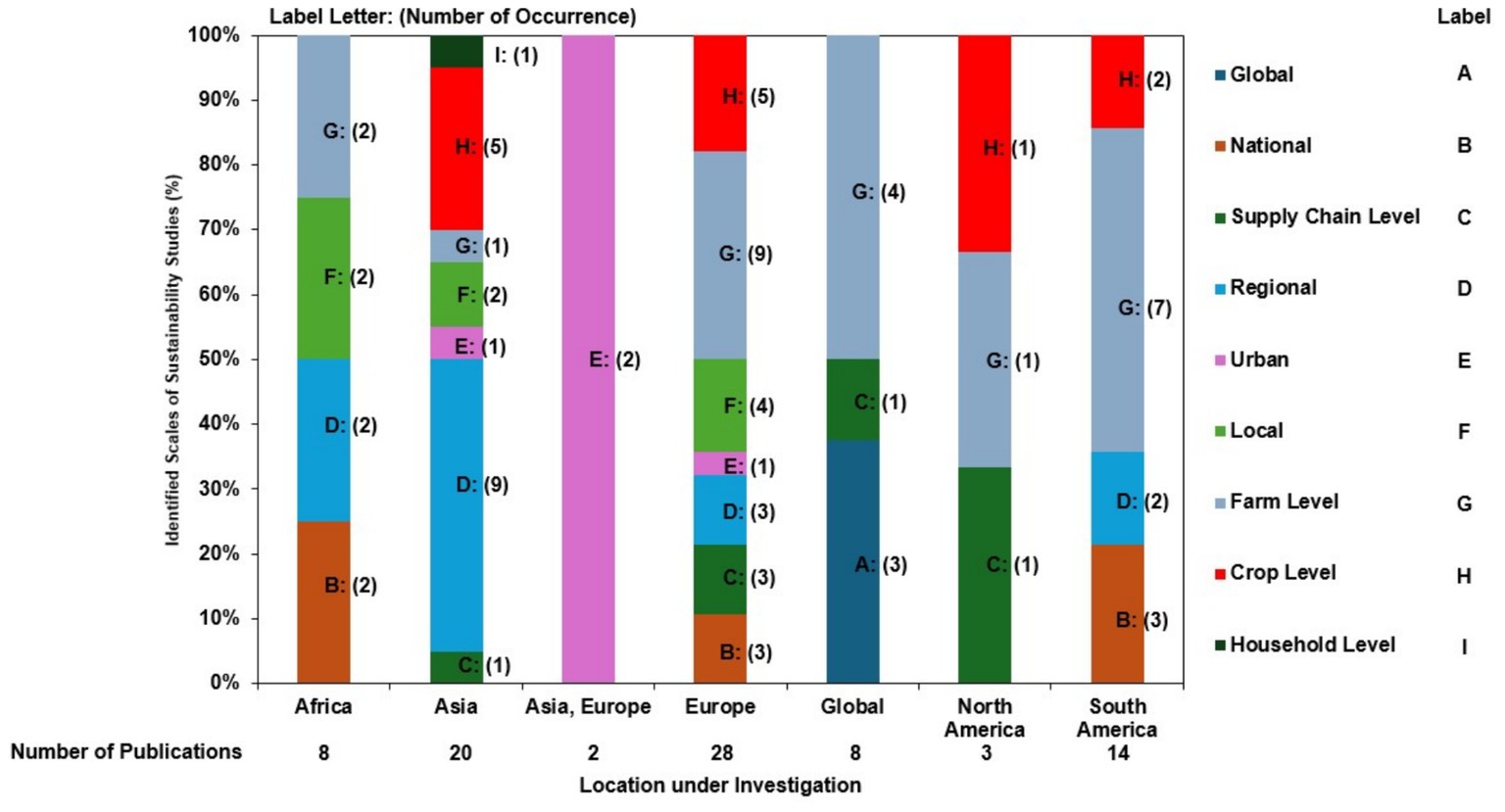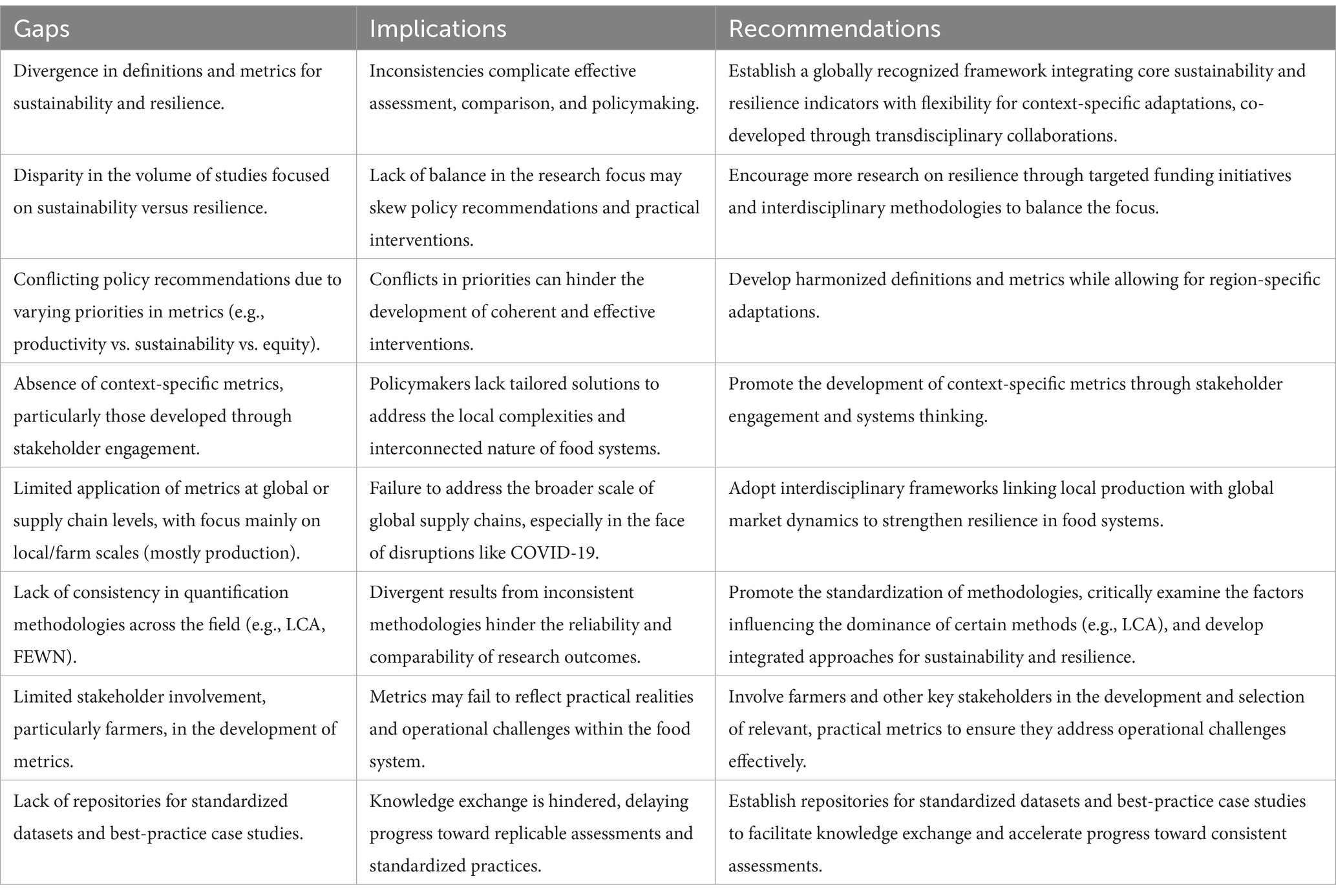- 1Faculty of Science and Technology, Norwegian University of Life Sciences (NMBU), Ås, Norway
- 2Texas A&M Energy Institute, Texas A&M University, College Station, TX, United States
- 3Artie McFerrin Department of Chemical Engineering, Texas A&M University, College Station, TX, United States
- 4Department of Biological and Agricultural Engineering, Texas A&M University, College Station, TX, United States
- 5Institute of Science Technology and Public Policy, Bush School of Government and Public Service, Texas A&M University, College Station, TX, United States
The global food system faces multiple challenges including growing demand, climate change, conflicts, economic shocks, pandemics, and disasters. Food systems aim to provide healthy and nutritious food for all, while minimizing environmental impacts, ensuring social equity and economic viability, and enhancing resilience to shocks and stresses. The fragility of the global food system has been exposed by COVID-19 and the Russia-Ukraine war, resulting in disruptions in supply chains and reduced access to food for vulnerable populations. Recognizing the importance of transitioning to more “sustainable” and “resilient” food systems, a notable gap exists in clear metrics for quantifying “sustainability” and “resilience,” hindering the ability to track progress and inform evidence-based decision-making. This paper explores the alignment of definitions and evaluation methods for “sustainability” and “resilience” in food systems literature, the diversity of existing metrics across regions and scales, and the distribution and distinctive characteristics of case studies that have implemented these quantification approaches. The analysis of the literature highlights a lack of consensus in defining food systems sustainability and resilience, highlighting the need for stakeholder- informed, context-specific metrics. The divergence observed in conceptualizations and methodologies illustrates challenges in achieving a unified assessment framework and bridging the gap between definitions and practical implementation. To address this, we propose the co-creation of practical, interpretable metrics tailored through stakeholder engagement, acknowledging the limitations of a one-size-fits-all approach. Notably, Life Cycle Assessment (LCA) and the Food-Energy-Water Nexus (FEWN) emerge as promising methodologies for comprehensively evaluating sustainability and resilience dimensions. This review underscores the importance of further conceptual and methodological refinement, alongside fostering regional and international collaboration, to advance the discourse and evidence-based action on sustainable and resilient food systems.
1 Introduction
The world is currently beset by multiple crises that pose significant threats to its food and nutrition security (FAO, 2021; The World Bank, 2022). Geopolitical instability, social unrest and climate stressors come on top as their destabilizing consequences aggravate the global food crisis (FSIN and Global Network Against Food Crises, 2021; World Economic Forum, 2021). Moreover, practices across the food system are on an unsustainable trajectory, encompassing issues such as land use and food production. Agriculture stands out as a significant contributor, responsible for almost a third of global greenhouse gas emissions (FAO, 2021).
This period of systemic disruption and escalating resource pressures demands a paradigm shift to mitigate the vulnerability and susceptibility to shocks within current food systems, minimizing their adverse impacts. Facilitating a holistic transformation and supporting policy adaptability and robustness necessitates the implementation of quantitative measures and a resilience-based approach. However, pathways considered must acknowledge sustainability as a fundamental attribute of future food systems. Recognizing the intrinsic interplay between sustainability and resilience is critical, with resilience serving as a prerequisite for achieving sustainability (Allen and Prosperi, 2016; O’Brien et al., 2012; Pisano, 2012; Tyler et al., 2013). There is an urgency to transform the current food systems to align with the global ambition to achieve the United Nation’s Sustainable Development Goals (SDGs) (Fanzo et al., 2020; FAO, IFAD, UNICEF, WFP, and WHO, 2021). This transformation must be harmonized with equitable livelihoods and healthy and environmentally friendly diets as well as environmental sustainability (Béné et al., 2019a; Lartey et al., 2018).
Currently, we can recognize the ongoing international efforts through the portfolios of different initiatives that span all over the food supply chain including the UN Food Systems Summit, The Global Agriculture and Food Security Program (GAFSP), and The Special Programme for Food Security (SPFS) (FAO, 2018; Food Systems Initiative, 2020; HLPE, 2014, 2017). The inherent complexity of food systems, coupled with growing systemic threats, has resulted in cascading challenges in their implementation. The COVID-19 pandemic was an example of such unforeseen challenges with long-term ripple effects. Another example is the Russia-Ukraine war that has induced a surge in the prices of staple crops and food products (Béné, 2020; OECD, 2021).
To fully leverage the benefits of this transformation and associated interventions while promoting stakeholder engagement, adopting a systems thinking approach is imperative (Bowman et al., 2015; FAO, 2018; O’Brien et al., 2012; Pisano, 2012). This approach enhances understanding of the complex properties and behaviors of food systems under both gradual and abrupt changes, allowing for the disentanglement of interconnectivity among economic, political, social, and environmental factors (Ericksen, 2008; Ingram, 2011). Furthermore, it provides a multidisciplinary lens to identify key drivers, interactions, and dynamics among various food-related sectors, thereby moving away from siloed approaches (Fanzo et al., 2021; Melesse et al., 2020). For example, adopting such an integrated perspective can unify both food production and consumption efforts (Von Braun et al., 2021), while also facilitating effective allocation of funding and resource planning to address unforeseen changes (Bowman et al., 2015; Food Systems Initiative, 2020; Ruben et al., 2021).
Food supply chains are central to this system transformation. This is due to the significant environmental footprints associated with current practices, resulting in key environmental feedback loops and complex interactions that increase the vulnerability of the overall system (Béné et al., 2019b; Crippa et al., 2021; Fanzo et al., 2020). Additionally, food systems governance represents a key leverage point that can support establishing the necessary enabling environment for food transformation and a long-term commitment needed at any level (Canfield et al., 2021; Fanzo et al., 2020, 2021; HLPE, 2017; Wezel et al., 2020). Current food policies primarily focus on boosting food production which is critical to sustaining the GDPs of many countries around the world (FAO, 2018). This underscores the prominent representation of The Ministry of Agriculture and its associated stakeholders as the primary actors in the stakeholders’ mapping (Ruben et al., 2021). Therefore, realigning current policies to catalyze food system transformation is crucial to creating plausible and robust policies capable of effectively responding to future disruptions (Dury et al., 2019; Fanzo et al., 2021; Holden et al., 2018).
Charting this transformative path starts with establishing a clear set of metrics that would allow for quantifying resilience and sustainability across food systems (Chaudhary et al., 2018; Fanzo et al., 2021; FAO, 2018). Melesse et al. (2020) identified the quantifiable measures “metrics” as “…a system of relevant indicators that provide a tool for measurement, comparison or tracking system performance.” Identifying metrics should be adapted to the specific food system component under study to reflect the status quo (binding constraints, leverage points), monitor performance, and be able to convey knowledge to convert to progressive policies (Fanzo et al., 2021). For instance, the metrics of food production should measure input utilization, productivity, and output levels (Melesse et al., 2020). As a result, these metrics should emerge as a response to the ongoing policy questions and should be characterized as interpretable and practical for policy discussions, actions coordination, and foresight analysis (Fanzo et al., 2021; Havardi-Burger et al., 2021; Rutten et al., 2018; Van Wassenaer et al., 2021). A few studies have reviewed the different metrics to quantify sustainability and resilience developed in the current body of food systems literature (Prosperi et al., 2016). Most of these studies focused on sustainability or resilience (Allen et al., 2019; Cabel and Oelofse, 2012; Constas et al., 2014; D’Errico et al., 2016; Food and Agriculture Organization of the United Nations, 2010; Padilla et al., 2015; Rutten et al., 2018; Seekell et al., 2017; Tyler et al., 2013; Zurek et al., 2017). This demonstrates the need to systematically map out and critically reflect on the existing metrics used. Also, it entails evaluating the overlap between sustainability and resilience metrics in food systems to enable any shift or action and monitor the system’s performance.
This paper addresses three core research questions: (1) To what extent do the definitions of “sustainability” and “resilience” in food systems literature align, and what quantification methods exist to evaluate them? (2) What types of metrics for evaluating sustainability and resilience in food systems exist in the literature, and how do these metrics vary across regions (Asia, Africa, Europe, etc.) and across scales (household, farm, urban, regional… global)? (3) What is the regional and scale-based distribution of case studies that have adopted sustainability and resilience quantification in food systems, and what unique features do these case studies exhibit?
To address these research questions, this paper aims to: (1) conduct a systematic review of the current literature to delineate the foundational concepts of “sustainability” and “resilience” in food systems and evaluate the level of convergence in their definitions; (2) identify and characterize the range of metrics used for evaluating food system sustainability and resilience; (3) evaluate the convergence between metrics for evaluating the sustainability and resilience of food systems in the reviewed literature; (4) map the regional and scale-based distribution of case studies that have implemented sustainability and resilience quantification, highlighting their unique features and contributions to advancing the discourse on food system transformation.
2 Conceptual challenges and definitions: food systems, sustainability, resilience
This section reviews diverse definitions of food systems, food system sustainability, and food system resilience, to analyze the convergence among these concepts. In this paper, we define “convergence” as the extent to which there is alignment or overlap in definitions and quantification methods and indicators for measuring sustainability and resilience of food systems.
2.1 Food systems
The absence of a universally agreed-upon definition for “food systems” is highly recognized within the literature (Von Braun et al., 2021; Canfield et al., 2021; Caron et al., 2018; Recine et al., 2021; HLPE, 2014). Each definition emerges from specific communities of practice and often manifests in descriptive forms rather than quantitative ones. This leads scholars and practitioners to grapple with the dynamic interplay between conceptual clarity and contextual specificity, resulting in diverse interpretations. This concept was broadly presented by Polly Ericksen using a conceptual framework encompassing drivers-activities-outcomes while acknowledging the intricate connections of environmental and socio-economic factors through feedback mechanisms (Ericksen, 2008). The High-Level Panel of Experts on Food Security and Nutrition (HLPE) presented another conceptual framework with an emphasis on diets and nutrition as vital outcomes “A food system gathers all the elements (environment, people, inputs, processes, infrastructures, institutions, etc.) and activities that relate to the production, processing, distribution, preparation, and consumption of food, and the output of these activities, including socio-economic and environmental outcomes” (HLPE, 2017). The Food and Agricultural Organization of the United Nations (FAO) considers food systems to “encompass the entire range of actors and their interlinked value-adding activities involved in the production, aggregation, processing, distribution, consumption, and disposal of food products that originate from agriculture, forestry or fisheries, and parts of the broader economic, societal and natural environments in which they are embedded. The food system is composed of sub-systems (e.g., farming system, waste management system, input supply system, etc.) and interacts with other key systems (e.g., energy system, trade system, health system, etc.).” The conceptual divergence in defining food systems and their key components may pose challenges in evaluating their performance and in guiding policies toward transformative action.
2.2 Resilience and sustainability
Navigating a fully operational food system transformation is further hindered by varying conceptualizations of sustainability and resilience, and the interplay among their dimensions (Béné et al., 2019a; Holden et al., 2018; Tendall et al., 2015; Van Wassenaer et al., 2021). Sustainability focuses on meeting the current needs of the food system while ensuring its future viability, whereas resilience enhances the system’s capacity to anticipate, absorb, recover from, and adapt to disruptions and shocks. These differing emphases on sustainability and resilience can complicate the measurement of system performance and the establishment of unified metrics, as each dimension requires distinct criteria and indicators to effectively evaluate and balance their respective goals (Marchese et al., 2018; Soubry and Sherren, 2022; Tendall et al., 2015).
Pisano (2012) and Van Wassenaer et al. (2021) present resilience as “The ability of a system to absorb disturbances and still retain its basic function and structure.” However, Béné and Doyen (2018) argue that the concept of resilience should not be limited to the system’s recovery, but rather extend to include systematic responses. Meanwhile, Tendall et al. (2015) present it as follows: “To build humankind’s capacity to attain today’s goals and meet their needs without compromising the future capacity to deliver the same.” Another definition was presented in New Zealand’s 2019 National Disaster Resilience Strategy that emphasizes long-term adaptation and provides a holistic framework to bridge the gap between reactive and proactive approaches: “The ability to anticipate and resist the effects of a disruptive event, minimize adverse impacts, respond effectively post-event, maintain or recover functionality, and adapt in a way that allows for learning and thriving.”
Similarly, Chrisandina et al. (2022) note that from a process systems engineering perspective, supply chain resilience can be defined as “The capability of a system to anticipate, absorb, adapt and recover in the face of a disruption”. Therefore, resilience can be understood as the ability to deal with unexpected deviations from nominal operation. This characteristic is similarly essential for sustainable system solution generation since these potential uncertain deviations can render process systems inherently environmentally and socially harmful (Di Martino et al., 2023). In essence, if systems are not sufficiently resilient, they cannot be sustainable.
Narrowing down these concepts for food systems, FAO (2018) defines a sustainable food system as “a system that delivers food security and nutrition for all in such a way that the economic, social and environmental bases to generate food security and nutrition for future generations are not compromised.” Tendall et al. (2015) defines a resilient food syst as the “Capacity over time of a food system and its units at multiple levels, to provide sufficient, appropriate and accessible food to all, in the face of various and even unforeseen disturbances.” The resilience of food systems requires a consolidated conceptualization (Van Wassenaer et al., 2021). As a result, grasping the full picture of what a resilient sustainable food system remains challenging and therefore, more efforts should be made to compose it systematically.
2.3 Summary of overlaps in concepts
Sustainability and resilience emerge in their mutual focus on maintaining the system’s ability to function over the long term. Both concepts consider social, environmental, and economic dimensions and recognize the importance of adapting to changes to support future generations. The integration of metrics assessing social and environmental impacts is common to both, illustrating that they both engage with holistic evaluations of food system performance (Figure 1). Summary of divergence in concepts becomes apparent when examining their core principles and approaches to change and adaptation. Sustainability primarily aims at proactive measures, emphasizing resource conservation, ecological balance, and intergenerational equity. It focuses on preventing environmental degradation and ensuring that current practices do not deplete resources for the future. In contrast, resilience emphasizes the system’s ability to react to disturbances and adapt to changes. It incorporates both proactive and reactive measures, focusing on how systems can recover from and adapt to disruptions, whether anticipated or unforeseen. The metrics for resilience often include adaptive capacity, flexibility, and recovery speed, which contrast with sustainability’s focus on long-term ecological balance and equity. In policy and practical application, these divergences can lead to challenges. While sustainability-oriented strategies may prioritize maintaining ecological integrity and long-term resource use, resilience-oriented policies might focus more on building infrastructure and capabilities that allow for rapid adaptation and recovery. This difference in focus may lead to conflicts or trade-offs when balancing sustainability’s long-term preventive measures with resilience’s immediate responsive needs.
3 Methodology
The methodology consists of a systematic review to map out metrics being used in the literature for quantifying the sustainability and resilience of food systems (Albrecht et al., 2018; Mittal et al., 2022; Palmatier et al., 2018). The following outlines the different steps of our approach (Figure 2).
3.1 Sampling and search strategy
We conducted a query for indexed peer-reviewed papers (articles and reviews), in English language between 2020 and 2022 in the Scopus database. This search targeted specific keywords within the abstract, title, and keywords fields. Scopus was selected as a database because of its extensive collection of journals across fields, although it tends to favor English-language journals with a high coverage of natural science, engineering, and biomedical journals than social sciences, arts, and humanities (Mongeon and Paul-Hus, 2016). It is important to note that this language restriction might introduce an implicit bias in the identified literature toward countries and regions speaking these languages. In tandem, through a snowballing method, the cited work of non-governmental and inter-governmental research and policy organizations in the identified research articles was reviewed and included in the analysis. Through this effort, the authors aimed to ensure that relevant grey literature has been considered in this review. The research team implemented an iterative review process, systematically discussing and refining coding decisions and the selection of grey literature to minimize subjective bias and enhance the methodological rigor of the process.
To carry out this search, the following keywords were used: “food systems,” “sustainability,” “resilience,” “metrics,” and “indicators” and the search process was narrowed down to the areas of Environmental Science and Agricultural and Biological Sciences as sub-areas to focus on listed in the Scopus database. Therefore, the resulting search line in Scopus was:
(TITLE-ABS-KEY (food AND systems, AND sustainability, OR resilience, AND metrics, OR indicators OR sustainable OR resilient OR agrifood AND system) AND PUBYEAR >2019 AND PUBYEAR <2023) AND ((indicators)) AND (food AND system) AND (LIMIT-TO (DOCTYPE, “ar”)) AND (LIMIT-TO (SUBJAREA, “ENVI”) OR LIMIT-TO (SUBJAREA, “AGRI”))
The outcome of this search was 1,038 documents, however, only 112 articles matched the objectives of this study by applying both inclusion criteria:
• Articles explicitly providing a conceptual framework for quantifying sustainability and resilience in the food system.
• Articles including metrics for quantifying, tracking, or monitoring the sustainability and resilience of food systems.
Articles were excluded if they:
• Did not explicitly provide a conceptual framework for quantifying sustainability and resilience in food systems.
• Did not include metrics for quantifying, tracking, or monitoring the sustainability and resilience of food systems.
• Focused solely on theoretical discussions without practical applications or quantifiable measures.
• Addressed sustainability or resilience in unrelated sectors outside the food system.
3.2 Data collection
The data collection approach was inspired by Albrecht et al. (2018) and Mittal et al. (2022). As a first step, the shortlisted papers first screened to extract information related to:
• The authors: (Names and lead author’s institution).
• Publication: (Journal, year of publication).
• Study focus: Sustainability and/or resilience.
• The paper’s purpose: The study aim and objectives as described by the authors.
The second step of data collection included extracting the following information:
• The metrics of sustainability and/or resilience of food systems:
a. Quantification method: e.g., LCA, sustainability impact assessment
b. The listed quantifiable metrics: e.g., indicators, determinants.
To map the regional and scale-based distribution of case studies that have implemented sustainability and resilience quantification, we compiled the following information:
• Case study: Is there a specific case study? Or does the paper only present a conceptual model or approach?
• Scale: Household level, crop level, farm level, local, urban, regional, supply chain level, national, global.
• Region: The region in which the case study is undertaken
3.3 Data analysis
The information was initially coded into categories to analyze the selected papers by journal and year, identify the institutions focusing on this topic, determine the proportion of papers addressing sustainability and/or resilience, and examine the common objectives stated by the authors. The identified quantification criteria were coded under sustainability or resilience categories, then compared to reveal similarities, differences, and gaps. Additionally, they were assessed to determine if they were cross-sectional or longitudinal. Finally, the assessment of quantifying sustainability and resilience in food systems considered the implementation scale and region. For example, research focused on local or regional scales often emphasizes community-driven initiatives, while studies at national or global scales tend to focus on policy frameworks, institutional coordination, and large-scale interventions.
The data analysis process involved an initial categorization of the collected data, with a focus on key aspects such as:
• Distribution of papers across journals and years,
• Institutions contributing to the topic (sustainable food systems, resilient food systems),
• The proportion of papers dedicated to sustainability and/or resilience,
• The stated objectives by authors.
Next, the identified quantification criteria were coded under either sustainability or resilience. This categorization also included an assessment of whether the studies were cross-sectional or longitudinal. In the final phase, case studies quantifying sustainability and resilience in food systems were evaluated by recognizing trends and patterns, including frequency of studies across regions and scales. The results are presented in the following section, emphasizing opportunities for future research on food systems transformation and providing actionable recommendations based on the analysis. Given the inherent context-specific nature of studies and their associated food supply chains at assessments at different scales, divergence among quantification metrics for food system sustainability and resilience is expected. While this observation was no surprise, this work makes an important contribution by mapping and cataloguing key quantification methodologies and metrics across diverse research focuses and scales, a gap in the current literature. By providing a structured glossary of these approaches, this work serves as a resource for researchers seeking to align their localized approaches with established metrics, enabling comparability and facilitating the transfer of insights between studies.
4 Results and analysis
4.1 Key features of the reviewed literature
To address the first research question of this paper—To what extent do the definitions of “sustainability” and “resilience” in food systems literature align, and what quantification methods exist to evaluate them?—this section examines the key features of the literature. Around 10% of the screened literature (112 of 1,038 articles) included metrics for quantifying sustainability and/or resilience in food systems. Our review reveals that most efforts are aimed at conceptually defining sustainability and/or resilience within the food system, rather than specifically providing quantifiable metrics. These efforts focus on offering descriptive visualization of sustainable and resilient food systems, emphasizing themes related to the development and governance of existing food systems. Thus, a key insight from the reviewed literature is that the development of explicit and reproducible metrics for quantifying sustainability and resilience in food systems remains in its early stages, with a notable absence of a comprehensive systems perspective.
Figure 3 shows that the overall 112 studies are divided as follows:
• The number of articles exclusively addressing sustainability is 102.
• The number of articles exclusively addressing resilience is 7.
• Finally, the number of articles that exclusively worked on sustainability and resilience is 3.
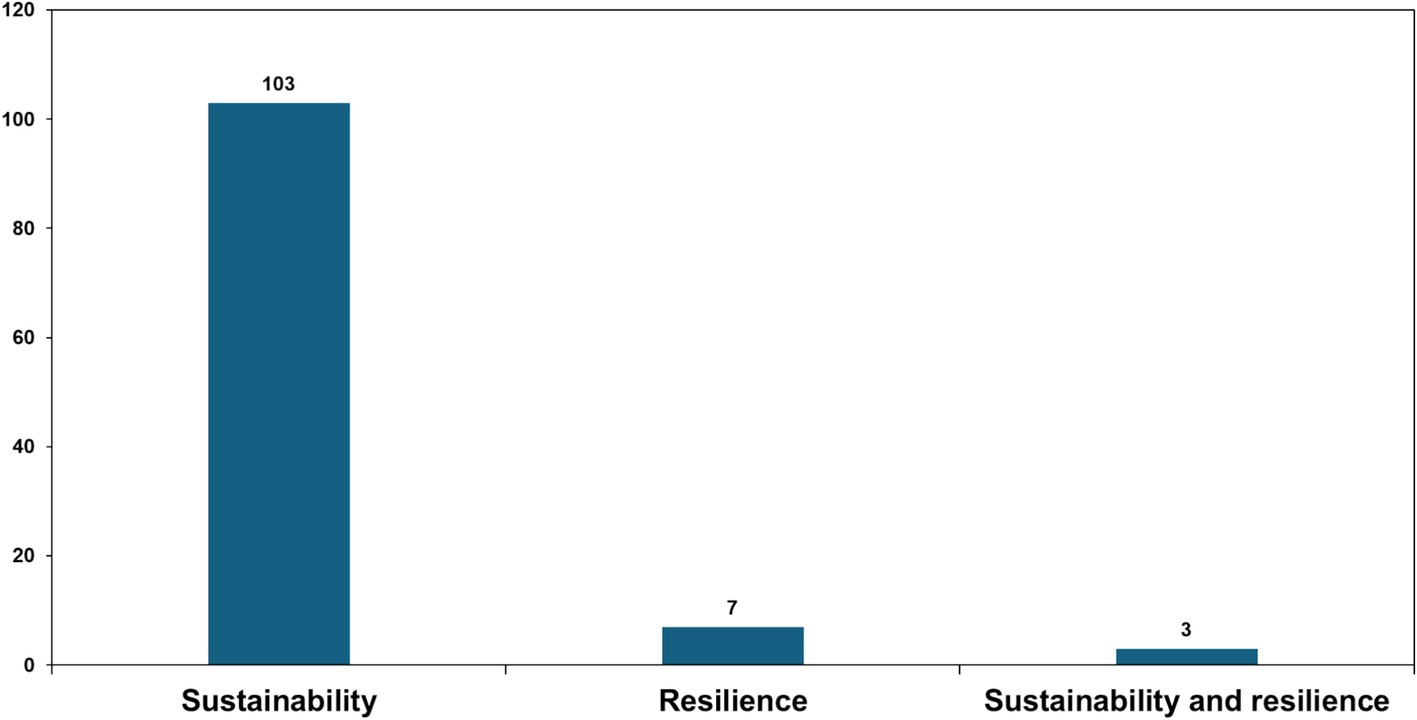
Figure 3. Classification of identified studies per research topic into sustainability, resilience, and sustainability and resilience.
The reviewed literature also highlights a dispersed global interest in this research topic, as evidenced by the distribution of lead author institutions. Italy notably stands out with 11 institutions engaged in quantification, indicating a significant interest within the research landscape. Figure 4 illustrates the worldwide distribution of lead author institutions for further insight.
In addressing the inherent complexity of food systems, we explored the thematic breadth of the literature and scrutinized each article’s objectives and their alignment to our overarching theme. Based on the author’s analysis of the 112 screened studies, seven categories emerged, with two key recurring objectives under each. Notably, these objectives span across various facets of the food system, tightly linked with stressors such as climate change resources like biodiversity and land. While the majority of articles focused on enhancing policy and governance frameworks within the current landscape, there was a noticeable absence of literature reflecting multi-sectoral collaboration and a systemic perspective. Figure 5 visually presents the key themes and objectives elucidated in the reviewed literature.
4.2 Quantification methods and metrics adopted in the reviewed literature
To address the first part of the second research question—What types of metrics for evaluating sustainability and resilience in food systems exist in the literature —this section explores the methods and metrics identified in the literature. It examines how these metrics are applied to quantify sustainability and resilience in food systems. Table 1 presents the categories of metrics reported by the authors of the 112 screened papers. The “example metrics” listed in the second column were selected to illustrate representative examples, along with their corresponding references. These categorizations (e.g., environmental, economic, social, governance, health, cultural, farming practices, circularity, flexibility, and security) reflect the multi-dimensional nature of food systems and align with the definitions and dimensions of sustainability and resilience identified in the literature. They aim to bridge conceptual gaps and provide a structured framework for quantifying food system performance, consistent with the broader definitions and frameworks discussed in Section 2. Each category addresses a specific dimension critical to assessing sustainability and resilience:
• Environmental: Metrics including emissions, biodiversity, and land use quantify the ecological footprint of food systems, aligning with sustainability’s focus on reducing environmental impacts.
• Economic: Metrics including production costs and profitability reflect the financial viability of food systems, critical for long-term sustainability.
• Social: Metrics including literacy and wage levels capture social equity and well-being, addressing the social pillar of sustainability.
• Governance: Metrics including stakeholder engagement and policy implementation evaluate institutional capacity, essential for creating adaptive and transformative systems.
• Health: Metrics including nutrition quality and pesticide exposure reflect human well-being, a fundamental goal of sustainable food systems.
• Cultural: Social inclusion and gender equality metrics emphasize the preservation of community values, integral to the social sustainability of food systems.
• Farming Practices: Metrics including crop rotation and soil management highlight the role of agricultural practices in enhancing both productivity and ecological resilience.
• Circularity: Recycling rates and waste reduction practices underscore the efficient use of resources, minimizing environmental impact and supporting sustainability.
• Flexibility: Metrics such as climate adaptability and food import capacity emphasize a system’s ability to respond to disruptions, a key attribute of resilience.
• Security: Food availability and supply chain transparency reflect stability and equitable access, crucial for both sustainability and resilience.
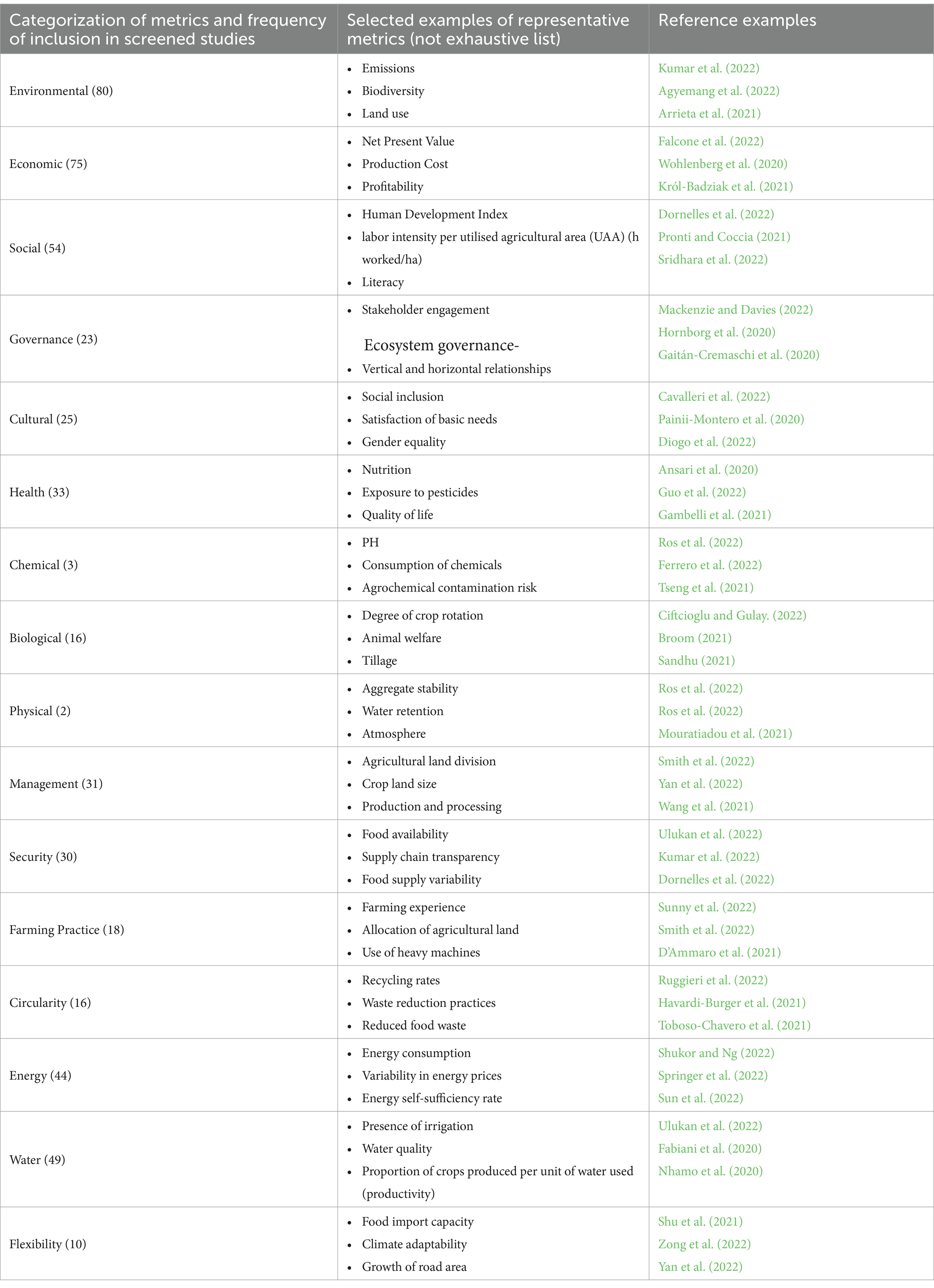
Table 1. Categorization of identified metrics to assess resilience and sustainability of food systems by theme.
In Table 1, we can see that Mouratiadou et al. (2021) for example utilize 1,128 metrics, including those related to biodiversity (76), productivity (70), food and nutrition (70), and soil characterization (61). While this level of detail allows for a nuanced analysis, it also hinders the application of the proposed methodology to other fields due to its inherent complexity. It is not uncommon among the identified studies that more than 100 indicators are utilized (Eggert et al., 2021; Heredia-R et al., 2022; Mackenzie and Davies, 2022). Some of these indicators are highly specialized which further hinders the applicability and transfer to other scenarios of performed studies. This also renders the performed analysis of this work challenging.
The categories included in the table were directly derived from the papers, not based on the authors’ interpretation or judgment. This diversity can be attributed to the varying concepts used in food system transformation, the diverse backgrounds of researchers, and the complex nature of food systems. Despite this, there is a noticeable lack of metrics specifically designed to assess food system vulnerability and associated risks. Water is a prominently recognized category, underscoring its critical role in transformation; however, related metrics could further include aspects of recycling and treatment. We can also appreciate a divergence between theoretical concepts or definitions and practical implementation. The open literature converged that sustainability consists of the three pillars of environmental, economic and social considerations. However, all three aspects are only considered in 42 out of 112 studies, all exclusively in the sustainability study category. This underlines that not only resilience can be a nebulous and vague concept, but sustainability as well, in the sense that not all dimensions of it are commonly explicitly investigated.
Furthermore, the plethora of utilized metrics and their relative occurrence can be visualized in Figure 6. It is not surprising that environmental and economic metrics are the most often incorporated metrics. However, after these two metrics, a drop in utilization frequency can be observed to around 39 to 48% for social, water and energy metrics. The next section constitutes around 20 to 30% of studies which include health, management, security, cultural and governance metrics. Next, farming practice, biological, circularity, and flexibility metrics are classified as contributors in the 10 to 20% range. Lastly, chemical and physical metrics are only used scarcely, i.e., in 2 to 3% of studies. Further, it is surprising that a lot of studies analyze environmental implications, but do not consider extensions to energy and water systems. This means that the full environmental impact can inherently not be analyzed by these approaches (Di Martino et al., 2023). Security and flexibility together can be understood as a prerequisite of a resilient process system (Chrisandina et al., 2022). Interestingly, security and flexibility are only evaluated together in 5 studies (Sustainability and Resilience: 1, Sustainabillity: 1, Resilience: 3). Security alone is analyzed in 24, and Flexibility alone in 4 sustainability studies. This indicates that indeed preliminary aspects of resilience are considered in 27 sustainability studies without explicitly stating it, which increases the initially observed penetration of resilience considerations in sustainability studies from 3 to 26%. However, in all studies on resilience and resilience combined with sustainability, no coherent metric or concept of resilience has been introduced.
Figures 7, 8 evaluate the utilized metrics category per location and scale to address the second part of the second research question—How do these metrics vary across regions (Asia, Africa, Europe, etc.) and across scales (household, farm, urban, regional, global)?.No clear convergence of used metrics per scale or location can be observed. This is a reflection of the absence of best practices or uniform framework for selecting quantification metrics per scale, location and research focus. It is observed that metrics related to the environmental category are present in all locations. Additionally, the metrics in Europe cover all the categories, although they do not have equal representation. We can recognize a more uniform representation of metrics linked to environmental, economy, water and energy in North America.
To further highlight this discussion, the employed quantification methods of all studies are summarized in Table 2 and analyzed next. Similar to the quantification metrics, the quantification methodologies are categorized based on their analytical framework and methodological approach. In this instance, we could summarize all methods under the following: sustainability impact assessment, life cycle analysis (LCA), Food-Energy-Water Nexus (FEWN) approach, Emergy synthesis, resilience assessment, or resilience and sustainability assessment. Most of the identified studies utilize historic data and tailored indices for various applications. Additionally, resource balancing and accounting across system boundaries are regularly employed as well. Less often, optimization approaches of identified indicators are leveraged. According to the selected topic, these approaches have been categorized as the respective assessment strategy. However, in 92 out of 112 studies, the presented theoretical concepts have been translated into a real-world impact which is an outstanding result within an FEWN context (Di Martino et al., 2022).
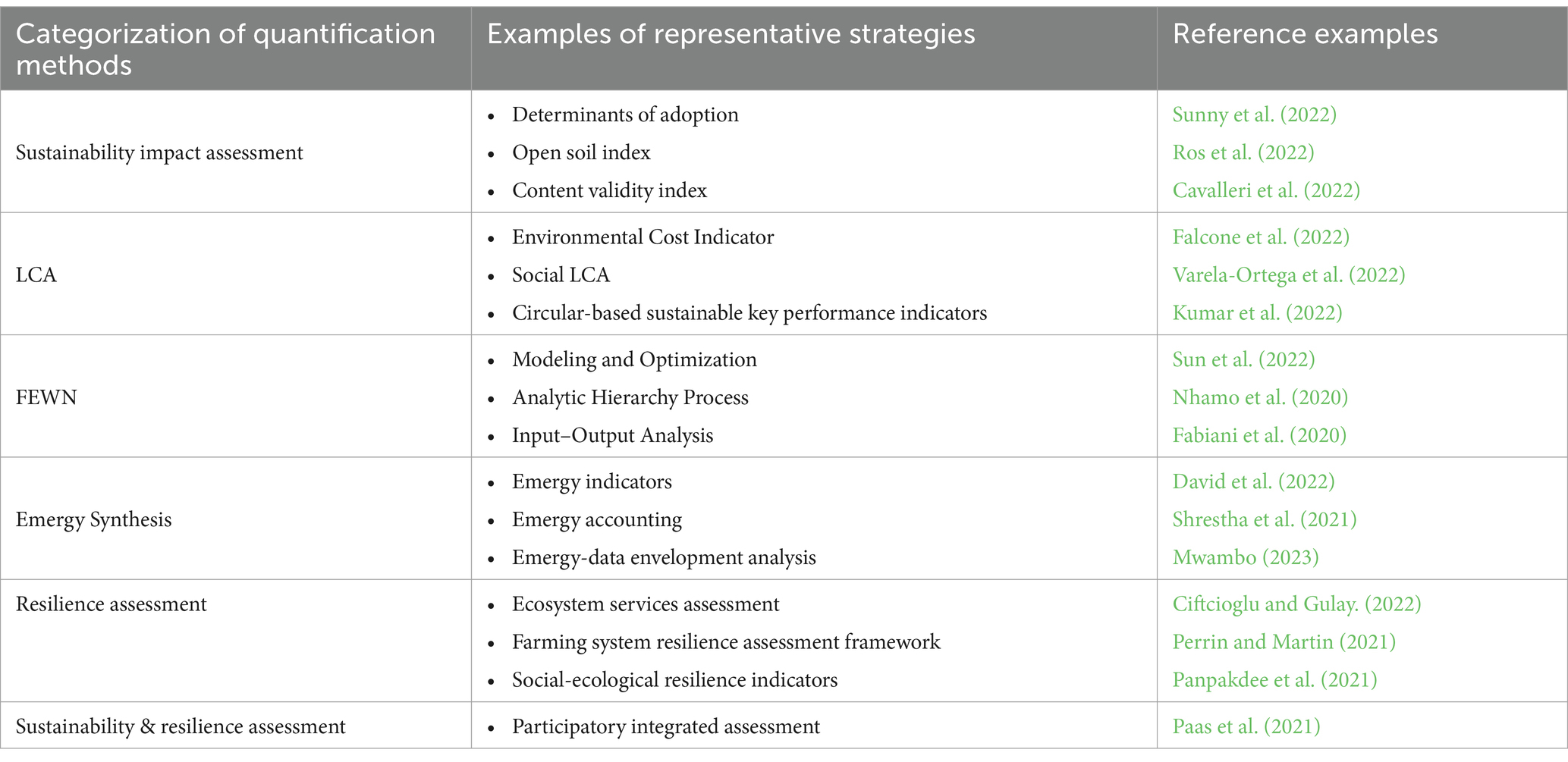
Table 2. Categorization of identified quantification methods to assess resilience and sustainability of food systems by theme.
Figure 9 further evaluates the selected quantification methods according to their employed scale and location under investigation, respectively. Interestingly, LCA and FEWN approaches are regularly employed besides sustainability impact assessment metrics followed by Energy Synthesis, resilience assessment and lastly resilience and sustainability assessment methods. Sustainability impact assessment is utilized in the majority of studies due to the strong potential of this approach to tailor it to specific case studies based on the introduction of specialized metrics or balances. In turn, it directly follows that one sustainability impact assessment strategy is potentially completely different from another one on the basis of the selection of fundamentally different performance metrics. This ties back to the identified absence of good practices for sustainability and resiliency assessment in food systems. This is further illustrated by the fact that there does not appear to be a clear utilization of a single quantification strategy for a single scale or location. In fact, the opposite is the case: each quantification methodology is utilized for a variety of scales and locations.
Figure 10 illustrates the metrics utilized for each quantification methodology. Overall, this figure underlines that across the quantification methods there is no clear convergence in utilized metrics, the only exception being Emergy synthesis which focuses mostly on environmental, economic, and energy metrics. Flexibility and security metrics are most often significant contributing metrics for FEWN, resilience assessment and resilience and sustainability assessment strategies. These two metrics can be understood as preliminary resiliency quantification metrics, which indicates that the FEWN can be leveraged as a powerful strategy to assess resiliency, besides the respective assessment strategies. On the other hand, LCA together with sustainability impact assessment employ regularly environmental, economic, and social metrics, i.e., all three pillars of sustainability, putting these approaches at the forefront of sustainability evaluation. One shortcoming of the FEWN and Emergy synthesis strategies is the missing incorporation of social aspects into the methodology. This metric, however, is regularly utilized in resiliency and resiliency and sustainability strategies. Interestingly, no energy or water metrics are used in resilience and sustainability assessment strategies. Similarly, no implications of system solutions to the water system are incorporated in Energy Synthesis. This highlights the missing interconnection of food systems to other resource supply systems for a holistic sustainability and resiliency evaluation outside FEWN strategies. Overall, Figure 10 underlines the complexity and the potential multiplicity of food system sustainability and resilience. In addition, a divergence, i.e., missing consistency, among sustainability and resiliency assessment strategies could be identified. Therefore, once again, we can identify the absence of defined good practices for the assessment of resiliency and sustainability of food systems which can facilitate to close these identified gaps.
4.3 The adoption of the concepts of sustainability and resilience in food systems
To address the third research question — What is the regional and scale-based distribution of case studies that have adopted sustainability and resilience quantification in food systems, and what unique features do these case studies exhibit? —this section highlights the global scope of the analyzed literature. The case studies within the examined literature spanned over 121 countries worldwide, underscoring the global significance and collective efforts dedicated to transformation initiatives. As previously mentioned, 92 publications present adoption strategies of suggested frameworks, i.e., translate their work into real-world action. In turn, the remaining 20 publications focus on pushing the boundaries of theoretical frameworks, such as developing novel agri-food supply chain mapping strategies (Ivo de Carvalho et al., 2022) or a multi-objective programming approach for the agricultural FEWN in a random environment (Li et al., 2019). The following section focuses on all publications presenting adoption strategies to analyze research advances of sustainability and resilience in food system practices.
The distribution of resilience and sustainability practices of food supply systems is visualized in Figure 11 (left). Zooming into the Mediterranean Basin, a notable concentration of case studies emerges in Spain, France, Italy, Greece, and Turkey. These countries are considered a part of Europe’s breadbasket and thus, these endeavors are interconnected with the continuous initiatives led by the European Commission to transform food systems and achieve food security, notably as part of the Green Deal and Farm to Fork Strategy. However, a scarcity of studies is prominent in the rest of the Mediterranean Basin, even though it is a recognized hotspot for climate change, confronting significant water scarcity challenges and agriculture is considered a major contribution to the GDP of each country.
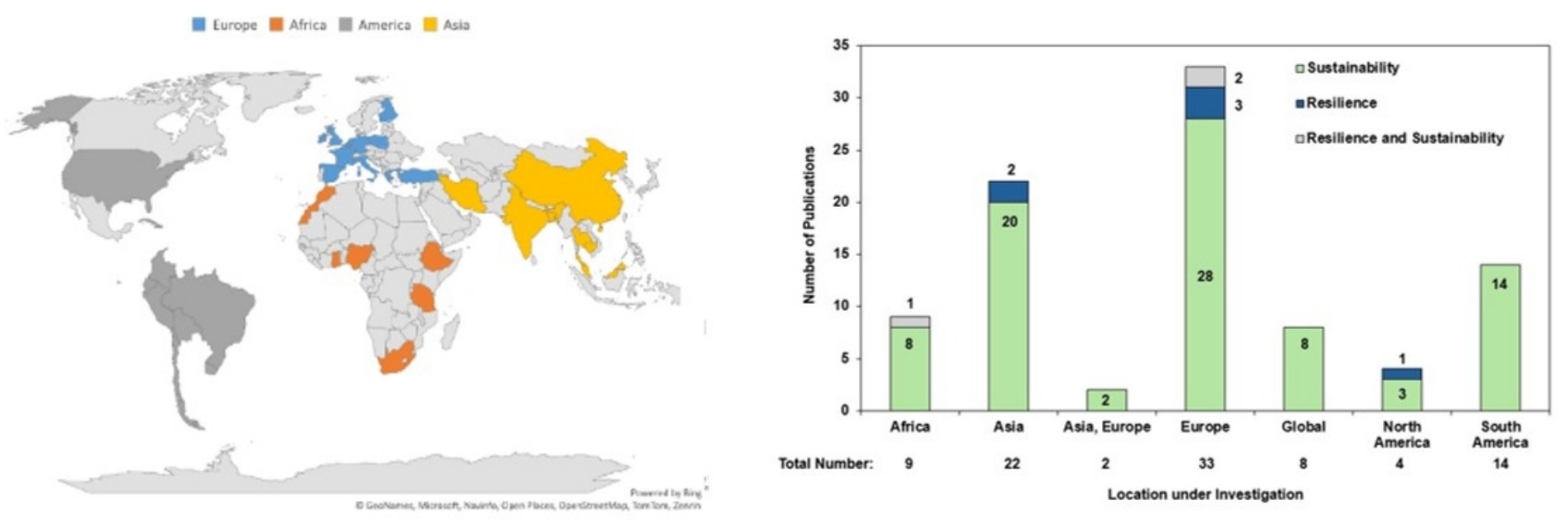
Figure 11. Global integration of sustainability and resilience practices in literature (left), together with the identified number of publications per research topic and location under investigation (right).
These observations can be further analyzed by examining the frequency of case studies across different continents, as illustrated in Figure 10 (right). This distribution highlights the locations investigated, with Australia and Antarctica being the only ones not covered. Interestingly, global analyses are relatively rare, which is surprising given the prominence of global supply chains and their disruption during the COVID-19 pandemic. Europe is the most studied continent in terms of the transformation fronts, which correlates with the location of the institutions researching these topics the most (Italy). A multi-continental investigation, i.e., Asia and Europe together (Eurasia), has only been studied in two publications. Indeed, only North and South America separately and not together have been studied, underlining the scarcity of multi- or inter-continental studies. Therefore, we can postulate that a multi-continental analysis, i.e., North and South America together, Africa and Asia, or around the Mediterranean Sea (Asia, Africa, and Europe) should be investigated in more detail. Indeed, water bodies such as the Mediterranean Sea, Red Sea (Africa – Asia), or Gulf of Mexico and Caribbean Sea (North America – South America) can potentially facilitate these future investigations as a potential basin for food systems sustainability and resiliency across continents.
These previous observations regarding the location under investigation are mirrored in the scales of the identified studies, as shown in Figure 12. The farm level is the most employed scale, whereas the household level is the least utilized scale. Intuitively, this is conclusive since the focus of the identified literature is food system resilience and sustainability. On the contrary the scarce investigation of supply chains and the utilization of global scales raises concerns post COVID-19 and can be identified as a significant research gap.
Figure 13 analyzes sustainability studies based on the identified scale and location of investigation. For each location, various scales have been utilized: multi-continent studies primarily compare urban food supply systems, while global investigations focus on supply chains, farm-level comparisons, and general global scales. Notably, in Europe and South America, the farm level is the most investigated scale, while in Asia, the regional scale is predominant. Africa shows an equal distribution across national, regional, local, and farm levels, and North America features a balanced focus on supply chain, farm, and crop levels. This variability underscores a shifting focus depending on the location of case studies, potentially influenced by the cultural backgrounds of research institutions and the evolving research fields addressing these challenges. This variability could signify differing regional priorities and research needs. It might reflect varying levels of infrastructure, resources, or policy focus in different regions. For instance, regions with advanced agricultural practices might focus more on farm-level studies, while those with significant supply chain issues might prioritize supply chain analyses. Additionally, it could indicate diverse responses to local challenges and opportunities in food system sustainability.
Similar to Figures 13, 14 (left) depicts the identified scales and locations for resiliency studies. One key observation is the reduction in number of studies and diversity of scales from changing study focus from sustainability to resilience. For Asia an equal share of farm and crop level studies can be seen. In turn, Europe has been analyzed more from a farm level than a national perspective, as was the case for sustainability studies, and North America has only been studied in terms of regional boundaries. It is surprising that for resilience studies of food systems no global, multi-continental or supply chain scales have been used. Lastly, Figure 14 (right) summarizes the scales and locations of resiliency and sustainability studies. As before, the number of studies and diversity of scales further reduces by combining a resilience and sustainability focus. Both concepts together have only been investigated based on a national or farm level scale. The reduction in scale diversity and the focus on national or farm-level studies for resilience and combined resilience-sustainability research may reveal underlying methodological constraints or data limitations. Additionally, the notable absence of global and supply chain analyses highlights a significant research gap that could impact the development of comprehensive strategies for enhancing food system resilience and sustainability on a broader scale. Addressing these gaps through interdisciplinary approaches and improved data collection could provide a more holistic understanding and better inform policy and practice.
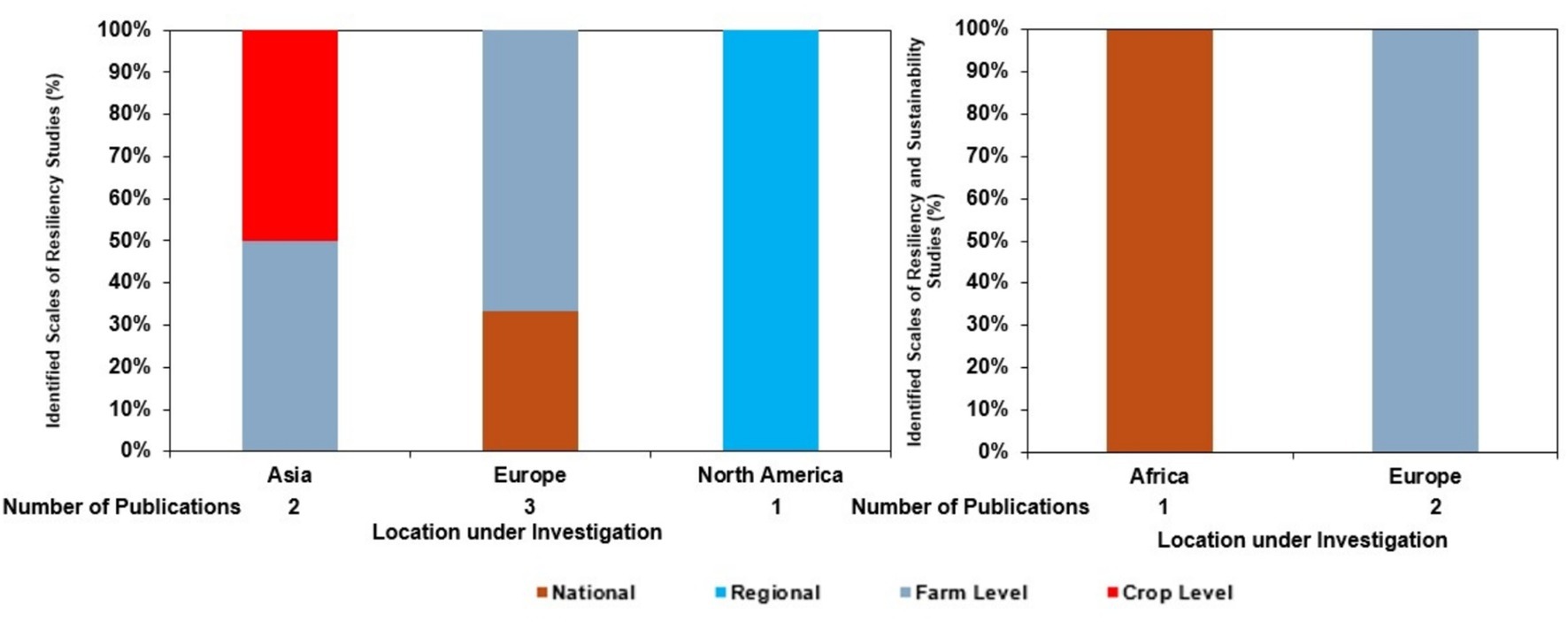
Figure 14. Scales under consideration per continent under investigation for resiliency studies only (left), as well as for resiliency and sustainability studies only (right).
5 Discussion
The analysis reveals significant variability in how sustainability and resilience metrics are applied across scales, regions, and thematic categories. While environmental and economic metrics dominate the literature, social, cultural, and governance indicators are notably underrepresented, reflecting a persistent gap in holistic assessments. Despite significant advances in understanding resilient and sustainable food systems, several gaps and limitations persist in the current approaches to quantification. One major gap is the lack of coherent and standardized metrics for assessing resilience (Fanzo et al., 2021; Melesse et al., 2020). This imbalance underscores the need for more integrative frameworks that move beyond traditional environmental-economic evaluations to include social equity, institutional capacity, and community engagement as core dimensions of food system sustainability and resilience. Additionally, the observed methodological diversity highlights a fragmented landscape where no single quantification approach has achieved widespread adoption. The frequent use of sustainability impact assessments and LCA suggests a preference for adaptable methods, yet the limited application of cross-sectoral frameworks like FEWN points to missed opportunities for integrated resource management.
The uneven geographic distribution of case studies further reveals disparities in research focus and institutional engagement. Regions facing critical food system vulnerabilities, such as parts of Africa and Asia, remain underrepresented despite their exposure to systemic shocks. Expanding research efforts in these contexts, supported by localized data collection and participatory research designs, could ensure more inclusive and globally representative assessments. Advancing such efforts is essential for creating transferable metrics that can inform global policy frameworks while respecting local complexities.
The transformation of food systems involves complex challenges in quantification, ideally requiring an integrated approach that captures all dimensions of sustainability and resilience across various components and timeframes, with input from relevant stakeholders and policies (Paas et al., 2021). However, implementing such a holistic approach results in complex, multi-scale models that often face issues with transferability and applicability. Simplifying these systems through model reduction techniques and carefully selecting key quantification metrics is therefore essential. A significant challenge is accurately assessing the impact of different scales on system performance. The unpredictability of shocks and disruptions, such as pandemics or geopolitical conflicts, further complicates this process (Béné, 2020; OECD, 2021). These events often introduce variables that the original models were not designed to handle, underscoring the need for adaptive models that can incorporate unexpected disruptions. The European Union’s Farm to Fork Strategy, for example, provides a roadmap for building sustainable and resilient food systems by integrating environmental, economic, and social dimensions. It underscores the importance of integrated, science-based, stakeholder engaged solutions in driving sustainable food system transformation. The strategy sets ambitious targets, such as reducing the environmental footprint of food systems, including a 50% reduction in pesticide use, cutting nutrient losses by at least 50%, and ensuring that 25% of agricultural land is under organic farming by 2030. It also emphasizes fair economic returns for farmers, reducing food waste, and promoting healthy diets. Stakeholder engagement is central to its implementation, promoting cooperation across the entire food value chain to ensure inclusive and adaptive decision making (European Commission, 2020).
Life Cycle Assessment (LCA) and Food-Energy-Water Nexus (FEWN) approaches present promising methods for addressing these challenges. LCA is effective for sustainability assessments, while FEWN provides valuable insights into resilience. However, the absence of standardized practices for integrating these methodologies leads to inconsistent quantification of resilience and sustainability, even when research objectives are similar. Timing and applicability of measurements across the food supply system pose additional challenges. Policies and decisions that impact the food system can have delayed effects, making it difficult to align measurements with current conditions. This lag highlights the need for adaptive and forward-looking approaches in policy-making that account for the inherent uncertainty and complexity of food systems. Addressing these limitations may benefit from a co-creation approach, involving stakeholders in the design and implementation of resource supply systems to enhance both sustainability and resilience. Understanding local contexts and engaging with relevant stakeholders to identify and apply appropriate metrics is crucial for effective transformation. Such approaches can help mitigate the negative effects of cascading policies and ensure more responsive and adaptive food system strategies.
Based on the performed analysis, we highlight in the following some remaining gaps and recommendations toward addressing them:
• Figures 7, 8, 10 highlight the divergence in definitions and metrics for sustainability and resilience which reflect a broader challenge in the field, where inconsistencies and varying interpretations complicate effective assessment and comparison. Notably, there is a substantial disparity in the volume of studies, with significantly more research focusing on sustainability compared to resilience. The divergence can create significant conflicts in the practical application of metrics. Different metrics often prioritize varying aspects of food systems—such as productivity, environmental sustainability, or social equity—which can potentially lead to conflicting policy recommendations or interventions. For instance, metrics focused on maximizing productivity may directly conflict with those aimed at promoting environmental sustainability or advancing social equity. The lack of consensus also creates challenges in tracking progress, comparing different food systems, and setting evidence-based policy goals. This divergence impedes the formulation of coherent interventions as policymakers lack a unified framework for evaluation and goal setting. On the other hand, the absence of context-specific metrics—developed through stakeholder engagement and systems thinking—hinders the creation of tailored policies that can address the complexity and interconnected nature of food systems. Working toward establishing a globally recognized framework that integrates core sustainability and resilience indicators while allowing flexibility for context-specific adaptations, could enhance comparability and cross-case learning. Such a framework should be co-developed through transdisciplinary collaborations involving researchers, policymakers, and practitioners from diverse regions and sectors. Such framework should prioritize harmonized definitions yet with flexibility in selecting contextually relevant metrics. Our mapping of available metrics in this paper offers an example of commonly used metrics to select from. On that front, research funding agencies can also play a role in proposing guidelines that can encourage the use of harmonized frameworks and interdisciplinary methodologies. Establishing repositories of standardized datasets and best-practice case studies could further support this endeavor, further allowing for knowledge exchange and accelerating progress toward replicable assessments of sustainable and resilient food systems.
• Adopting a systems approach is essential for effective food system transformation (Fanzo et al., 2020; FAO, IFAD, UNICEF, WFP, and WHO, 2021). Such approach considers the interconnections and feedback loops between different components of the food system, allowing for a holistic understanding of how changes in one area impact others. By addressing the system as a whole rather than in isolated parts, researchers and policymakers can develop more integrated and sustainable strategies that address both immediate challenges and long-term goals.
• The inherent complexity of food systems, characterized by their multifaceted interactions and dependencies, underscores the need for interdisciplinary research collaborations. Integrating expertise from environmental science, economics, social sciences, and engineering is crucial to developing comprehensive metrics that accurately reflect the diverse dimensions of food systems. Such collaborations can help create representative metrics that capture the interplay between various factors and ensure that assessments are robust and applicable across different contexts.
• Including stakeholders, particularly farmers, in the process of metrics identification is vital for developing relevant and practical measures. Farmers, as primary actors within the food system, possess critical insights into the realities of agricultural practices and the impacts of various metrics on their operations. Engaging them in the development of metrics ensures that the measures are grounded in practical experience and effectively address the challenges faced at the operational level, leading to more actionable and impactful outcomes. In the Argentine Chaco dry forest, for example, stakeholders, including agribusiness actors, co-produced sustainability indicators to balance agricultural production with conservation. This participatory approach facilitated the development of an online decision-support platform, which integrates social-ecological considerations into sustainable land-use planning (Piquer-Rodríguez et al., 2024).
• Figures 13, 14 indicate a focus on local and farm-level scales, with minimal application that cover the global or supply chain dynamics. This gap is particularly concerning in the context of disruptions like COVID-19, which highlighted the vulnerabilities of interconnected global supply chains. Adopting interdisciplinary frameworks that link local production with global market dynamics would enhance the capacity of food system research to inform resilient and sustainable supply chain management.
• Regarding quantification methodologies, there is a notable lack of consistency across the field, Figure 10. While methodologies such as Life Cycle Assessment (LCA) and the Food-Energy-Water Nexus (FEWN) show considerable potential, their application remains uneven. LCA has proven particularly effective for sustainability assessments, offering detailed insights into environmental impacts. In contrast, FEWN is more commonly used to measure resilience, providing a framework for understanding system interactions and vulnerabilities. However, the absence of best practices leads to divergent results, even when addressing similar research objectives. We recognize the importance of a more critical examination of why certain methodologies, like LCA, dominate the field. Gaining a better understanding of factors such as methodological accessibility, data requirements, and the alignment of these approaches with specific food system goals could shed light on their prevalence and utility. We encourage the investigation of these underlying factors and to work toward developing more integrated and standardized methods for assessing both sustainability and resilience in food systems. Such efforts would support a more cohesive, reliable framework for future research and policymaking.
Table 3 summarizes key gaps identified in the literature, their implications for food system research and policymaking, and corresponding recommendations to address these challenges. It provides a structured overview to guide future efforts in enhancing the consistency, relevance, and applicability of sustainability and resilience metrics in food systems.
6 Conclusion
This review emphasizes the urgent need for the development of more systematic and comprehensive approaches to quantification regarding sustainability and resilience of food systems. While these dimensions are increasingly gaining recognition, current metrics remain highly fragmented, and there is substantial variability across definitions, methodological frameworks, and scales of analysis. The review indicates that in most studies, the dimension of sustainability is emphasized instead of resilience, with a very limited integration of both. Furthermore, the observed emphasis on local and farm-level analyses, together with the shortage of global and supply chain-focused research, underlines a critical research gap that hinders the understanding of systemic vulnerabilities in interconnected food systems, such as those posed by global crises like COVID-19 or geopolitical conflicts like the Russia-Ukraine war. A key insight arising from this review is the need to balance developing harmonized frameworks with preservation of flexibility for context-specific metrics. On one hand, standardization allows comparability, cross-case learning, and informs global policy frameworks. On the other hand, rigid application of universal indicators risks overlooking unique socio-economic, environmental, and institutional contexts in which food systems operate. The co-development of metrics by participatory processes involving a diverse set of stakeholders at different levels, from policymakers to researchers, practitioners, and local communities, could provide such a balance. These collaborative efforts will ensure that metrics are scientifically robust yet contextually relevant and actionable.
Methodological approaches such as LCA and the FEWN framework emerge as promising tools to assess sustainability and resilience, respectively. However, inconsistent application of these methodologies across studies points to the need for clearer best-practice guidelines. Establishing a globally recognized framework that integrates core sustainability and resilience indicators while accommodating regional and contextual differences could reduce fragmentation. In this context, research funding agencies can play a pivotal role by incentivizing interdisciplinary projects and supporting the development of standardized data repositories and open-access databases for cross-study comparability. Further strengthening of the evidence base will be achieved by expanding research efforts toward underrepresented regions and the adoption of multiscale approaches, from local to global supply chain analyses. The integration of insights from these wider contexts will enable the elaboration of more adaptive and inclusive policy frameworks that can respond to both immediate shocks and long-term challenges. Ultimately, moving toward more sustainable and resilient food systems will require a twofold commitment: standardization of metrics where possible, combined with the unleashing of innovation through context-sensitive approaches fitted to diverse food system realities. This integrative vision can help bridge the persistent gaps in food systems research and guide transformative action toward more resilient, sustainable, and equitable global food systems.
Data availability statement
The original contributions presented in the study are included in the article/supplementary material, further inquiries can be directed to the corresponding author.
Author contributions
RH: Conceptualization, Formal analysis, Methodology, Writing – original draft, Writing – review & editing, Data curation, Investigation, Validation. MDM: Formal analysis, Methodology, Writing – original draft, Writing – review & editing, Visualization. BD: Formal analysis, Methodology, Visualization, Writing – original draft, Writing – review & editing, Conceptualization, Project administration, Resources, Supervision, Investigation.
Funding
The author(s) declare that financial support was received for the research, authorship, and/or publication of this article. This research has been partially supported by NSF Award Number: 2201446 and NIH Project Number: 1P20TW012709-01.
Conflict of interest
The authors declare that the research was conducted in the absence of any commercial or financial relationships that could be construed as a potential conflict of interest.
The author(s) declared that they were an editorial board member of Frontiers, at the time of submission. This had no impact on the peer review process and the final decision.
Publisher’s note
All claims expressed in this article are solely those of the authors and do not necessarily represent those of their affiliated organizations, or those of the publisher, the editors and the reviewers. Any product that may be evaluated in this article, or claim that may be made by its manufacturer, is not guaranteed or endorsed by the publisher.
References
Agyemang, P., Kwofie, E. M., and Fabrice, A. (2022). Integrating framework analysis, scenario design, and decision support system for sustainable healthy food system analysis. J. Clean. Prod. 372:133661. doi: 10.1016/j.jclepro.2022.133661
Albrecht, T. R., Crootof, A., and Scott, C. A. (2018). The water-energy-food Nexus: a systematic review of methods for Nexus assessment. Environ. Res. Lett. 13. doi: 10.1088/1748-9326/aaa9c6
Allen, T., and Prosperi, P. (2016). Modeling sustainable food systems. Environ. Manag. 57, 956–975. doi: 10.1007/s00267-016-0664-8
Allen, T., Prosperi, P., Cogill, B., Padilla, M., and Peri, I. (2019). A Delphi approach to develop sustainable food system metrics. Soc. Indic. Res. 141, 1307–1339. doi: 10.1007/s11205-018-1865-8
Ansari, E., Loubna, R. C., Yigezu, Y. A., Gary, C., and Belhouchette, H. (2020). Trade-offs between sustainability indicators in response to the production choices of different farm household types in drylands. Agronomy 10:998. doi: 10.3390/agronomy10070998
Arrieta, E. M., Geri, M., Coquet, J. B., Scavuzzo, C. M., Zapata, M. E., and González, A. D. (2021). Quality and environmental footprints of diets by socio-economic status in Argentina. Sci. Total Environ. 801:149686. doi: 10.1016/j.scitotenv.2021.149686
Béné, C. (2020). Resilience of local food systems and links to food security – a review of some important concepts in the context of COVID-19 and other shocks. Food Sec. 12, 805–822. doi: 10.1007/s12571-020-01076-1
Béné, C., and Doyen, L. (2018). From resistance to transformation: a generic metric of resilience through viability. Earth’s Future 6, 979–996. doi: 10.1002/2017EF000660
Béné, C., Oosterveer, P., Lamotte, L., Brouwer, I. D., de Haan, S., Prager, S. D., et al. (2019a). When food systems meet sustainability – current narratives and implications for actions. World Dev. 113, 116–130. doi: 10.1016/j.worlddev.2018.08.011
Béné, C., Prager, S. D., Achicanoy, H. A. E., Toro, P. A., Lamotte, L., Bonilla, C., et al. (2019b). Global map and indicators of food system sustainability. Scientific Data 6, 1–15. doi: 10.1038/s41597-019-0301-5
Broom, D. M. (2021). A method for assessing sustainability, with beef production as an example. Biol. Rev. 96, 1836–1853. doi: 10.1111/brv.12726
Bowman, K., Chettleborough, J., Jeans, H., Whitehead, J., and Rowlands, J. (2015). Systems Thinking: An introduction for Oxfam programme staff. Oxfam. Available at: https://oxfamilibrary.openrepository.com/bitstream/handle/10546/579896/ml-systems-thinking-151020-en.pdf?sequence=1
Cabel, J. F., and Oelofse, M. (2012). An Indicator framework for assessing agroecosystem resilience. Ecol. Soc. 17. doi: 10.5751/ES-04666-170118
Canfield, M., Anderson, M. D., and McMichael, P. (2021). UN Food Systems Summit 2021: Dismantling democracy and resetting corporate control of food systems. Frontiers in Sustainable Food Systems, 5:661552. doi: 10.3389/fsufs.2021.661552
Caron, P., Ferrero y de Loma-Osorio, G., Nabarro, D., Hainzelin, E., Guillou, M., Andersen, I., et al. (2018). Food systems for sustainable development: proposals for a profound four-part transformation. Agron. Sustain. Dev. 38:41. doi: 10.1007/s13593-018-0519-1
Cavalleri, S. A., Enrica, P. T., and Grünbühel, C. M. (2022). Systemizing a rural livelihood diversification framework for sustainable community-based Agritourism: a participatory approach to ensure resilience. Front. Sustain. Food Syst. 6:993892. doi: 10.3389/fsufs.2022.993892
Chaudhary, A., Gustafson, D., and Mathys, A. (2018). Multi-indicator sustainability assessment of global food systems. Nat. Commun. 9:3308. doi: 10.1038/s41467-018-03308-7
Chrisandina, N. J., Vedant, S., Iakovou, E., Pistikopoulos, E. N., and El-Halwagi, M. M. (2022). Multi-scale integration for enhanced resilience of sustainable energy supply chains: perspectives and challenges. Comput. Chem. Eng. 164:107891. doi: 10.1016/j.compchemeng.2022.107891
Ciftcioglu, C., and Gulay, C. (2022). Assessment of the resilience of the agricultural landscapes and associated ecosystem Services at Multiple Scales (a farm and landscape) in Kyrenia (Girne) region of northern Cyprus. Landsc. Ecol. Eng. 18, 277–298. doi: 10.1007/s11355-022-00498-7
Constas, M. A., Frankenberger, T. R., and Hoddinott, J. (2014). Resilience measurement principles: Toward an agenda for measurement design. Food Security Information Network.
Crippa, M., Solazzo, E., Guizzardi, D., Monforti-Ferrario, F., Tubiello, F. N., and Leip, A. (2021). Food systems are responsible for a third of global anthropogenic GHG emissions. Nature Food 2, 198–209. doi: 10.1038/s43016-021-00225-9
D’Ammaro, D., Capri, E., Valentino, F., Grillo, S., Fiorini, E., and Lamastra, L. (2021). Benchmarking of carbon footprint data from the Italian wine sector: a comprehensive and extended analysis. Sci. Total Environ. 779:146416. doi: 10.1016/j.scitotenv.2021.146416
D’Errico, M., Garbero, A., and Constas, M. (2016). Quantitative analyses for resilience measurement. Guidance for Constructing Variables and Exploring Relationships among Variables. Rome.
David, L. O., Nwulu, N. I., Aigbavboa, C. O., and Adepoju, O. O. (2022). Integrating fourth industrial revolution (4IR) technologies into the water, energy & food Nexus for sustainable security: a bibliometric analysis. J. Clean. Prod. 363:132522. doi: 10.1016/j.jclepro.2022.132522
de Carvalho, I., Mafalda, S. R., and Barbosa-Póvoa, A. P. (2022). A roadmap for sustainability performance assessment in the context of Agri-food supply chain. Sustain. Product. Consumpt. 34, 565–585. doi: 10.1016/j.spc.2022.10.001
Di Martino, M., Allen, R. C., and Pistikopoulos, E. N. (2022). “The food-energy-water Nexus in sustainable energy systems solutions” in Handbook of smart energy systems (Cham: Springer International Publishing), 1–20.
Di Martino, M., Linke, P., and Pistikopoulos, E. N. (2023). A comprehensive classification of food–energy–water Nexus optimization studies: state of the art. J. Clean. Prod. 420:138293. doi: 10.1016/j.jclepro.2023.138293
Diogo, V., Helfenstein, J., Mohr, F., Varghese, V., Debonne, N., Levers, C., et al. (2022). Developing context-specific frameworks for integrated sustainability assessment of agricultural intensity change: an application for Europe. Environ. Sci. Pol. 137, 128–142. doi: 10.1016/j.envsci.2022.08.014
Dornelles, A. Z., Boonstra, W. J., Izabela Delabre, J., Denney, M., Nunes, R. J., Jentsch, A., et al. (2022). Transformation archetypes in global food systems. Sustain. Sci. 17, 1827–1840. doi: 10.1007/s11625-022-01102-5
Dury, S., Bendjebbar, P., Hainzelin, E., Giordano, T., and Bricas, N. (2019). Food Systems at Risk: New trends and challenges. Rome: FAO, CIRAD and European Commission.
Eggert, H., Anderson, C. M., Anderson, J. L., and Garlock, T. M. (2021). Assessing global fisheries using fisheries performance indicators: introduction to special section. Mar. Policy 125:104253. doi: 10.1016/j.marpol.2020.104253
Ericksen, P. J. (2008). Conceptualizing food Systems for Global Environmental Change Research. Glob. Environ. Chang. 18, 234–245. doi: 10.1016/j.gloenvcha.2007.09.002
European Commission. (2020). Farm to fork strategy. Available online at: https://ec.europa.eu/food/horizontal-topics/farm-fork-strategy_en
Fabiani, S., Vanino, S., Napoli, R., and Nino, P. (2020). Water energy food Nexus approach for sustainability assessment at farm level: an experience from an intensive agricultural area in Central Italy. Environ. Sci. Pol. 104, 1–12. doi: 10.1016/j.envsci.2019.10.008
Falcone, G., Stillitano, T., Iofrida, N., Spada, E., Bernardi, B., Gulisano, G., et al. (2022). Life cycle and circularity metrics to measure the sustainability of closed-loop Agri-food pathways. Front. Sustain. Food Systems 6:1014228. doi: 10.3389/fsufs.2022.1014228
Fanzo, J., Covic, N., Dobermann, A., Henson, S., Herrero, M., Pingali, P., et al. (2020). A research vision for food systems in the 2020s: defying the status quo. Glob. Food Sec. 26:100397. doi: 10.1016/j.gfs.2020.100397
Fanzo, J., Haddad, L., Schneider, K. R., Béné, C., Covic, N. M., Guarin, A., et al. (2021). Viewpoint: rigorous monitoring is necessary to guide food system transformation in the countdown to the 2030 global goals. Food Policy 104:102163. doi: 10.1016/j.foodpol.2021.102163
FAO. (2018). Sustainable food systems - concept and framework. Food and Agriculture Organization of the United Nations.
FAO. (2021). The state of the World’s land and water Resouces for food and agriculture: Systems at Breaking Point. Food and Agriculture Organization of the United Nations.
FAO, IFAD, UNICEF, WFP, and WHO (2021). Transforming food Systems for Food Security, improved nutrition and affordable healthy diets for all. Rome: FAO.
Ferrero, M., Lucas, M., Wheeler, J., and Mele, F. D. (2022). Life cycle assessment of the argentine lemon and its derivatives in a circular economy context. Sustain. Product. Consumpt. 29, 672–684. doi: 10.1016/j.spc.2021.11.014
Food and Agriculture Organization of the United Nations. (2010). Measuring resilience: A concept note on the resilience tool. Rome: FAO. Available at: https://www.fao.org/4/al920e/al920e00.pdf
Food Systems Initiative (2020). Incentivizing food systems transformation. Geneva: Food Systems Initiative.
Gaitán-Cremaschi, D., Klerkx, L., Duncan, J., Trienekens, J. H., Huenchuleo, C., Dogliotti, S., et al. (2020). Sustainability transition pathways through ecological intensification: an assessment of vegetable food systems in Chile. Int. J. Agric. Sustain. 18, 131–150. doi: 10.1080/14735903.2020.1722561
Gambelli, D., Solfanelli, F., Orsini, S., and Zanoli, R. (2021). Measuring the economic performance of small ruminant farms using balanced scorecard and importance-performance analysis: a European case study. Sustain. For. 13:3321. doi: 10.3390/su13063321
Guo, X., Wang, C., and Zhang, F. (2022). Construction of an index system for sustainability assessment in smallholder farming systems. Front. Agric. Sci. Eng. 9:511. doi: 10.15302/J-FASE-2022463
Havardi-Burger, N., Mempel, H., and Bitsch, V. (2021). Framework for sustainability assessment of the value chain of flowering potted plants for the German market. J. Clean. Prod. 329:129684. doi: 10.1016/j.jclepro.2021.129684
Heredia-R, M., Torres, B., Vasseur, L., Puhl, L., Barreto, D., and Díaz-Ambrona, C. G. H. (2022). Sustainability dimensions assessment in four traditional agricultural Systems in the Amazon. Front. Sustain. Food Syst. 5:782633. doi: 10.3389/fsufs.2021.782633
Holden, N. M., White, E. P., Lange, M. C., and Oldfield, T. L. (2018). Review of the sustainability of food systems and transition using the internet of food. Npj Sci. Food 2:27. doi: 10.1038/S41538-018-0027-3
Hornborg, S., Hobday, A. J., Ogier, E., Fleming, A., Thomas, L., and Hartog, J. R. (2020). Challenges and insights from holistic sustainability reporting for shrimp fisheries in different jurisdictions. ICES J. Mar. Sci. 77, 2022–2032. doi: 10.1093/icesjms/fsaa048
Ingram, J. (2011). A food systems approach to researching food security and its interactions with global environmental change. Food security, 3, 417–431. doi: 10.1007/s12571-011-0149-9
Król-Badziak, A., Pishgar-Komleh, S. H., Rozakis, S., and Księżak, J. (2021). Environmental and socio-economic performance of different tillage Systems in Maize Grain Production: application of life cycle assessment and multi-criteria decision making. J. Clean. Prod. 278:123792. doi: 10.1016/j.jclepro.2020.123792
Kumar, M., Sharma, M., Raut, R. D., Mangla, S. K., and Choubey, V. K. (2022). Performance assessment of circular driven sustainable Agri-food supply chain towards achieving sustainable consumption and production. J. Clean. Prod. 372:133698. doi: 10.1016/j.jclepro.2022.133698
Lartey, A., Meerman, J., and Wijesinha-Bettoni, R. (2018). Why food system transformation is essential and how nutrition scientists can contribute. Ann. Nutr. Metab. 72, 193–201. doi: 10.1159/000487605
Li, M., Qiang, F., Singh, V. P., Ji, Y., Liu, D., Zhang, C., et al. (2019). An optimal modelling approach for managing agricultural water-energy-food Nexus under uncertainty. Sci. Total Environ. 651, 1416–1434. doi: 10.1016/j.scitotenv.2018.09.291
Mackenzie, S. G., and Davies, A. R. (2022). Assessing the sustainability impacts of food sharing initiatives: user testing the toolshed SIA. Front. Sustain. Food Syst. 6:807690. doi: 10.3389/fsufs.2022.807690
Marchese, D., Reynolds, E., Bates, M. E., Morgan, H., Clark, S. S., and Linkov, I. (2018). Resilience and sustainability: similarities and differences in environmental management applications. Sci. Total Environ. 613-614, 1275–1283. doi: 10.1016/j.scitotenv.2017.09.086
Melesse, M. B., van den Berg, M., Béné, C., de Brauw, A., and Brouwer, I. D. (2020). Metrics to analyze and improve diets through food Systems in low and Middle Income Countries. Food Secur. 12, 1085–1105. doi: 10.1007/s12571-020-01091-2
Mittal, A., Scholten, L., and Kapelan, Z. (2022). A review of serious games for urban water management decisions: current gaps and future research directions. Water Res. 215:118217. doi: 10.1016/j.watres.2022.118217
Mongeon, P., and Paul-Hus, A. (2016). The journal coverage of web of science and Scopus: a comparative analysis. Scientometrics 106, 213–228. doi: 10.1007/s11192-015-1765-5
Mouratiadou, I., Latka, C., van der Hilst, F., Müller, C., Berges, R., Bodirsky, B. L., et al. (2021). Quantifying sustainable intensification of agriculture: the contribution of metrics and modelling. Ecol. Indic. 129:107870. doi: 10.1016/j.ecolind.2021.107870
Mwambo, F. M. (2023). The Emergy-data envelopment analysis (EM-DEA) approach handbook: an illustrated guide on how to use the EM-DEA approach to assess resource- and energy-use efficiency and the sustainability of agricultural and forestry ecosystems. Bogor: Center for International Forestry Research (CIFOR).
Nhamo, L., Mabhaudhi, T., Mpandeli, S., Dickens, C., Nhemachena, C., Senzanje, A., et al. (2020). An integrative analytical model for the water-energy-food Nexus: South Africa case study. Environ. Sci. Pol. 109, 15–24. doi: 10.1016/j.envsci.2020.04.010
O’Brien, K. M., Oki Pelling, T., Patwardhan, A., Hallegatte, S., Maskrey, A., Oswald-Spring, U., et al. (2012). Building toward a sustainable and resilient future. Cambridge, UK, and New York, NY, USA: Cambridge University Press.
Paas, W., Martín, C. S., Soriano, B., van Ittersum, M. K., Meuwissen, M. P. M., and Reidsma, P. (2021). Assessing future sustainability and resilience of farming systems with a participatory method: a case study on extensive sheep farming in Huesca, Spain. Ecol. Indic. 132:108236. doi: 10.1016/j.ecolind.2021.108236
Padilla, M., Cogill, B., Prosperi, P., Allen, T., and Peri, I. (2015). Metrics of sustainable diets and food systems insights from a multi-institutional research partnership. Montpellier. International Centre for Advanced Mediterranean Agronomic Studies (CIHEAM).
Painii-Montero, V. F., Santillán-Muñoz, O., Barcos-Arias, M., Portalanza, D., Durigon, A., and Garcés-Fiallos, F. R. (2020). Towards indicators of sustainable development for soybeans productive units: a multicriteria perspective for the Ecuadorian coast. Ecol. Indic. 119:106800. doi: 10.1016/j.ecolind.2020.106800
Palmatier, R. W., Houston, M. B., and Hulland, J. (2018). Review articles: purpose, process, and structure. J. Acad. Mark. Sci. 46, 1–5. doi: 10.1007/s11747-017-0563-4
Panpakdee, C., Limnirankul, B., and Kramol, P. (2021). Assessing the social-ecological resilience of organic farmers in Chiang Mai Province, Thailand. Forest Society 631–649, 631–649. doi: 10.24259/fs.v5i2.13268
Perrin, A., and Martin, G. (2021). Resilience of French organic dairy cattle farms and supply chains to the Covid-19 pandemic. Agric. Syst. 190:103082. doi: 10.1016/j.agsy.2021.103082
Piquer-Rodríguez, M., Aragón, R., Pacheco, S., Malizia, S., and Zunino, H. (2024). Co-production of sustainability indicators in a vulnerable south American agricultural frontier. Reg. Environ. Chang. 24. doi: 10.1007/s10113-024-02340-2
Pisano, U. (2012). Resilience and sustainable development: theory of resilience, systems thinking and adaptive governance.
Pronti, A., and Coccia, M. (2021). Multicriteria analysis of the sustainability performance between agroecological and conventional coffee farms in the east region of Minas Gerais (Brazil). Renew. Agric. Food Syst. 36, 299–306. doi: 10.1017/S1742170520000332
Prosperi, P., Allen, T., Cogill, B., Padilla, M., and Peri, I. (2016). Towards metrics of sustainable food systems: a review of the resilience and vulnerability literature. Environ. Syst. Decis. 36, 3–19. doi: 10.1007/s10669-016-9584-7
Recine, E., Preiss, P. V., Valencia, M., and Zanella, M. A. (2021). The Indispensable Territorial Dimension of Food Supply: A View from Brazil During the COVID-19 Pandemic. Development 64, 282–287. doi: 10.1057/s41301-021-00308-x
Ros, G. H., Verweij, S. E., Janssen, S. J. C., De Haan, J., and Fujita, Y. (2022). An open soil health assessment framework facilitating sustainable soil management. Environ. Sci. Technol. 56, 17375–17384. doi: 10.1021/acs.est.2c04516
Ruben, R., Cavatassi, R., Lipper, L., Smaling, E., and Winters, P. (2021). Towards food systems transformation—five paradigm shifts for healthy, inclusive and sustainable food systems. Food Security, 13, 1423–1430. doi: 10.1007/s12571-021-01221-4
Ruggieri, A., Poponi, S., Pacchera, F., and Fortuna, F. (2022). Life cycle-based dashboard for circular Agri-food sector. Int. J. Life Cycle Assess. 29, 1393–1408. doi: 10.1007/s11367-022-02118-w
Rutten, M., Achterbosch, T. J., de Boer, I. J. M., Cuaresma, J. C., Geleijnse, J. M., Havlík, P., et al. (2018). Metrics, models and foresight for European sustainable food and nutrition security: the vision of the SUSFANS project. Agric. Syst. 163, 45–57. doi: 10.1016/j.agsy.2016.10.014
Sandhu, H. (2021). Bottom-up transformation of agriculture and food systems. Sustainability, 13, 2171. doi: 10.3390/su13042171
Seekell, D., Carr, J., Dell’Angelo, J., D’Odorico, P., Fader, M., Gephart, J., et al. (2017). Resilience in the global food system. Environ. Res. Lett. 12:025010. doi: 10.1088/1748-9326/aa5730
Shrestha, K., Shah, I. H., Liu, Z., and Park, H.-S. (2021). Regional sustainability assessment using Emergy accounting approach: the case of Nepal in South Asia. Environ. Eng. Res. 27:210329, –210320. doi: 10.4491/eer.2021.329
Shu, Q., Scott, M., Todman, L., and McGrane, S. J. (2021). Development of a prototype composite Index for resilience and security of water-energy-food (WEF) Systems in Industrialised Nations. Environ. Sustain. Indicators 11:100124. doi: 10.1016/j.indic.2021.100124
Shukor, S. A., and Ng, G. K. (2022). Environmental indicators for sustainability assessment in edible oil processing industry based on Delphi method. Cleaner Eng. Technol. 10:100558. doi: 10.1016/j.clet.2022.100558
Smith, O. M., Jocson, D. M. I., Lee, B. W., Orpet, R. J., Taylor, J. M., Davis, A. G., et al. (2022). Identifying farming strategies associated with achieving global agricultural sustainability. Front. Sustain. Food Syst. 6:882503. doi: 10.3389/fsufs.2022.882503
Soubry, B., and Sherren, K. (2022). ‘You keep using that word…’: Disjointed definitions of resilience in food systems adaptation. Land Use Policy 114:105954. doi: 10.1016/j.landusepol.2021.105954
Springer, N. P., Hollander, A. D., Huber, P. R., Riggle, C., and Tomich, T. P. (2022). A malleable workflow for identifying the issues and indicators that define and measure sustainability in food systems. Front. Sustain. Food Syst. 6:684831. doi: 10.3389/fsufs.2022.684831
Sridhara, S., Gopakkali, P., Manoj, K. N., Kiran, K. R., Patil, V. P., Jha, P. K., et al. (2022). Identification of sustainable development priorities for agriculture through sustainable livelihood security indicators for Karnataka, India. Sustain. For. 14:1831. doi: 10.3390/su14031831
Sun, L., Niu, D., Min, Y., Li, M., Yang, X., and Ji, Z. (2022). Integrated assessment of the sustainable water-energy-food Nexus in China: case studies on multi-regional sustainability and multi-sectoral synergy. J. Clean. Prod. 334:130235. doi: 10.1016/j.jclepro.2021.130235
Sunny, F. A., Karimanzira, T. T. P., Wenhuan Peng, M., Rahman, S., and Zuhui, H. (2022). Understanding the determinants and impact of the adoption of Technologies for Sustainable Farming Systems in water-scarce areas of Bangladesh. Front. Sustain. Food Syst. 6:961034. doi: 10.3389/fsufs.2022.961034
Tendall, D. M., Joerin, J., Kopainsky, B., Edwards, P., Shreck, A., Le, Q. B., et al. (2015). Food system resilience: defining the concept. Glob. Food Sec. 6, 17–23. doi: 10.1016/j.gfs.2015.08.001
Toboso-Chavero, S., Madrid-López, C., Durany, X. G., and Villalba, G. (2021). Incorporating user preferences in rooftop food-energy-water production through integrated sustainability assessment *. Environ. Res. Commun. 3:065001. doi: 10.1088/2515-7620/abffa5
Tseng, M.-C., Roel, Á., Macedo, I., Marella, M., Terra, J. A., and Pittelkow, C. M. (2021). Synergies and tradeoffs among yield, resource use efficiency, and environmental footprint indicators in Rice systems. Curr. Res. Environ. Sustain. 3:100070. doi: 10.1016/j.crsust.2021.100070
Tyler, S., Keller, M., Swanson, D., Bizikova, L., Hammill, A., Zamudio, A. N., et al. (2013). Climate resilience and food security a framework for planning and monitoring ii International Institute for Sustainable Development Climate Resilience and Food Security a Framework for planning and monitoring.
Ulukan, D., Bergkvist, G., Lana, M., Fasse, A., Mager, G., Öborn, I., et al. (2022). Combining sustainable livelihood and farm sustainability approaches to identify relevant intensification options: implications for households with crop-based and gathering-based livelihoods in Tanzania. Ecol. Indic. 144:109518. doi: 10.1016/j.ecolind.2022.109518
Varela-Ortega, C., Blanco-Gutiérrez, I., Manners, R., and Detzel, A. (2022). Life cycle assessment of animal-based foods and plant-based protein-rich alternatives: a socio-economic perspective. J. Sci. Food Agric. 102, 5111–5120. doi: 10.1002/jsfa.11655
Von Braun, J., Afsana, K., Fresco, L. O., Hassan, M., and Torero, M. (2021). Food system concepts and definitions for science and political action. Nat Food 2, 748–750. doi: 10.1038/s43016-021-00361-2
Wang, N., Zhu, L., Bing, Y., Chen, L., and Fei, S. (2021). Assessment of urban agriculture for evidence-based food planning: a case study in Chengdu, China. Sustain. For. 13:3234. doi: 10.3390/su13063234
Wassenaer, V., Lan, E. O., van Asseldonk, M., and Ryan, M. (2021). Food system resilience: ontology development and impossible trinities. Agriculture Food Security 10, 1–15. doi: 10.1186/s40066-021-00332-7
Wezel, A., Herren, B. G., Kerr, R. B., Barrios, E., Gonçalves, A. L. R., and Sinclair, F. (2020). Agroecological principles and elements and their implications for transitioning to sustainable food systems. A review. Agronomy for Sustainable Development, 40, 1–13. doi: 10.1007/s13593-020-00646-z
Wohlenberg, J., Schneider, R. C. S., and Hoeltz, M. (2020). Sustainability indicators in the context of family farming: a systematic and bibliometric approach. Environ. Eng. Res. 27:200545. doi: 10.4491/eer.2020.545
Yan, M., Yang, B., Sheng, S., Fan, X., Li, X., and Xinhai, L. (2022). Evaluation of cropland system resilience to climate change at municipal scale through robustness, adaptability, and transformability: a case study of Hubei Province, China. Front. Ecol. Evol. 10:943265. doi: 10.3389/fevo.2022.943265
Zong, X., Liu, X., Chen, G., and Yin, Y. (2022). A deep-understanding framework and assessment Indicator system for climate-resilient agriculture. Ecol. Indic. 136:108597. doi: 10.1016/j.ecolind.2022.108597
Keywords: food system transformation, multi-scale metrics, systems thinking, sustainable development, evidence-based decision-making
Citation: Hassan R, Di Martino M and Daher B (2025) Quantifying sustainability and resilience in food systems: a systematic analysis for evaluating the convergence of current methodologies and metrics. Front. Sustain. Food Syst. 9:1479691. doi: 10.3389/fsufs.2025.1479691
Edited by:
Rakesh Bhardwaj, Indian Council of Agricultural Research (ICAR), IndiaReviewed by:
Patrick Baur, University of Rhode Island, United StatesShalander Kumar, International Crops Research Institute for the Semi-Arid Tropics (ICRISAT), India
Copyright © 2025 Hassan, Di Martino and Daher. This is an open-access article distributed under the terms of the Creative Commons Attribution License (CC BY). The use, distribution or reproduction in other forums is permitted, provided the original author(s) and the copyright owner(s) are credited and that the original publication in this journal is cited, in accordance with accepted academic practice. No use, distribution or reproduction is permitted which does not comply with these terms.
*Correspondence: Bassel Daher, YmRhaGVyQHRhbXUuZWR1
 Rasha Hassan
Rasha Hassan Marcello Di Martino
Marcello Di Martino Bassel Daher
Bassel Daher